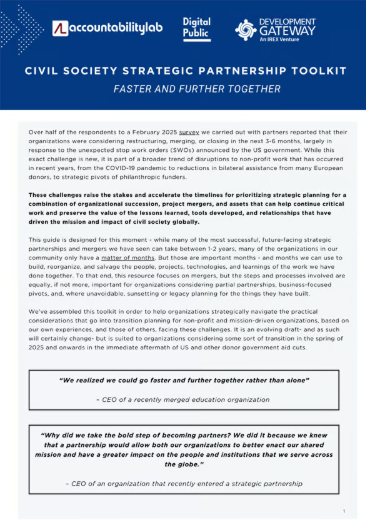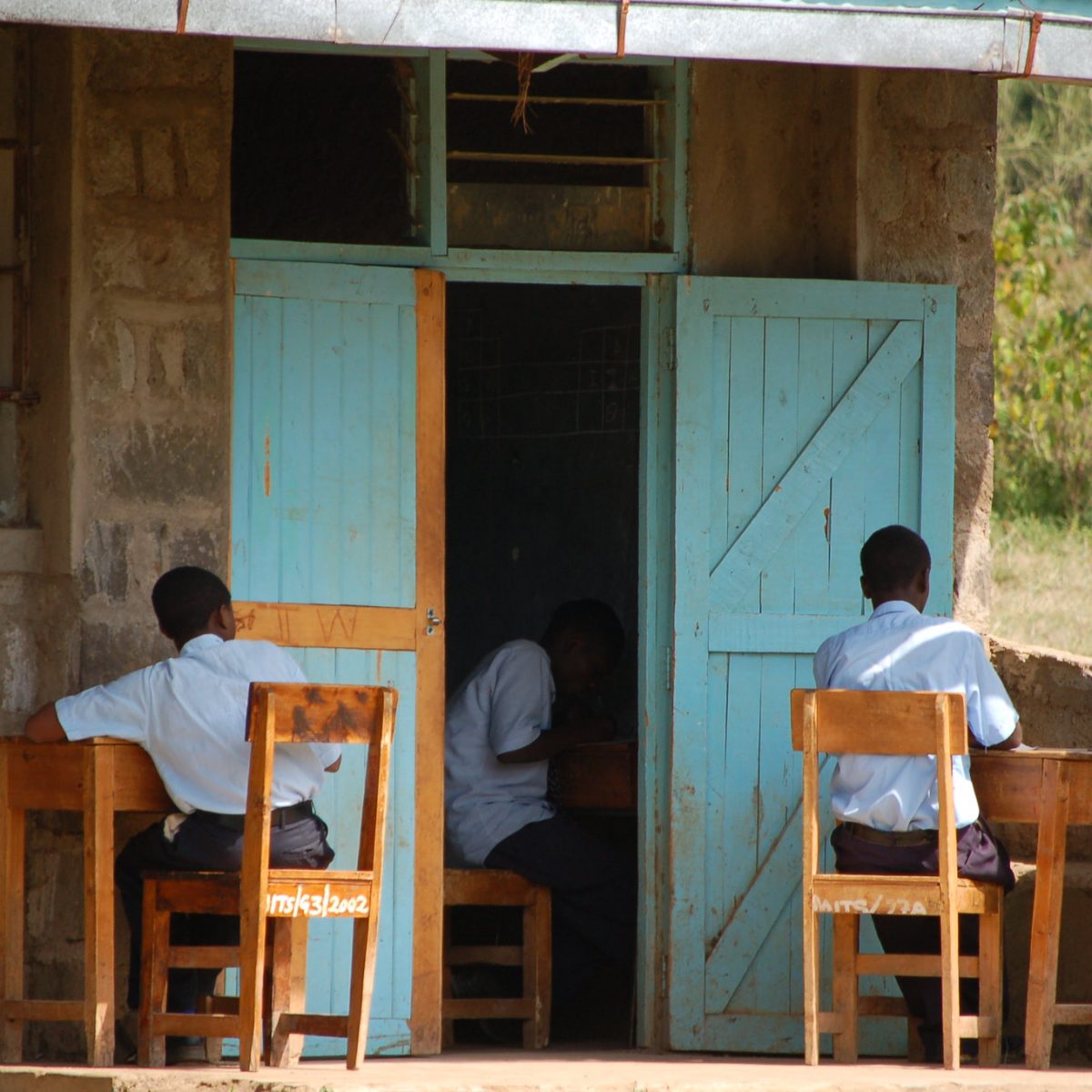
Shared Struggles, Shared Solutions: Education and Cross-Sector Data Use Insights
“Education is the most powerful weapon which you can use to change the world.” ~ Nelson Mandela
Education has long been recognized as a crucial driver in creating a more sustainable and equitable world. However, to understand how education is being delivered, who it reaches, where, and how effectively, we must first have access to quality, reliable educational data.
Across many sectors, countries, and contexts, Development Gateway: An IREX Venture (DG) has seen first-hand what makes data, technology, and evidence effective. Through this process, we have learned best practices for advising governments, agencies, and organizations on how to take practical, action-oriented steps to collect, monitor, evaluate, and use data to achieve impact.
This blog draws on DG’s experience in climate, health, aid management, and agriculture to explore connections between the challenges of data collection, data hosting, and data governance across different sectors and what the solutions to overcoming them can teach us about strengthening education data systems.
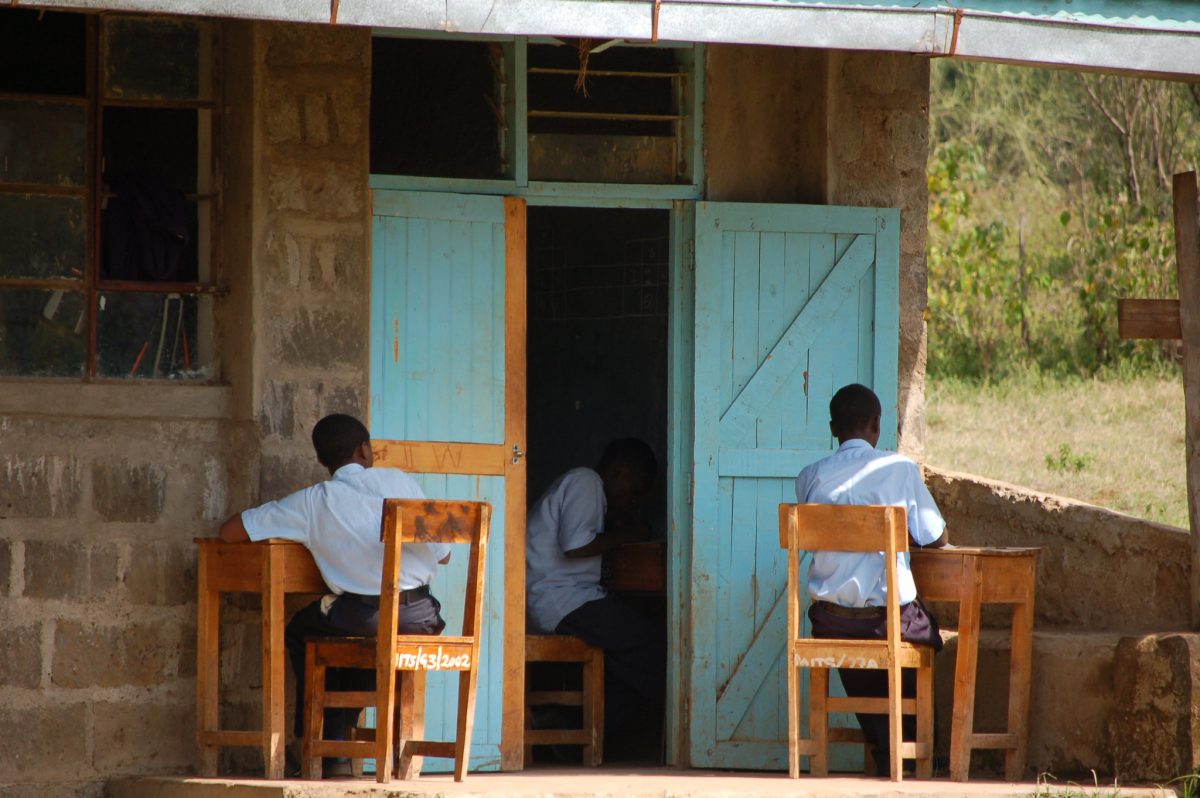
Overview of the EDI Project
In our latest education project, the Elimu Data Initiative (EDI), we aim to understand the existing open- and closed-source educational information management systems that track education data.
In the first iteration of this project, Hewlett 1.0 (2022 – 2024), DG conducted desk reviews and a series of stakeholder assessments to understand the education data ecosystems in Kenya and Senegal, culminating in a comparative white paper. As we enter into the project’s second phase with EDI, our aim is to grow on the successes of Hewlett 1.0. The project also aims to:
- Assess and understand the existing landscape of digital systems being used for education data management through a paper comparing education management information systems;
- Contribute to thought leadership on digital tools for education through discussion of and engagement with our learnings from the paper; and
- Conduct stakeholder interviews with Nairobi County officials, who indicated a strong need for digital approaches in education.
As we’ve begun these project activities, we’ve encountered recurring challenges in data collection, data hosting, and data governance. Reflecting on these challenges across multiple sectors, ranging from health to agriculture, can lead to innovative solutions that improve outcomes for the education sector.
Data Challenges: Perspectives from Multiple Sectors
Challenge #1: Data Collection
A challenge we have repeatedly encountered in various sectors is the collection and collation of data. In our white paper on Education Data-Driven Decision Mapping, for instance, stakeholders cited challenges with collecting data on student performance and other data entries. Teachers are often asked to spend a significant amount of time entering data into multiple online systems. Due to the lack of data sharing between these systems, teachers often struggle to balance other teaching priorities while simultaneously completing numerous lengthy forms. This pattern is a recurring trend in the education sector we have witnessed in a number of countries, from Jordan to Kenya.
However, data collection challenges aren’t unique to the education sector and have been an issue in DG’s creation of digital solutions in other sectors, too. In our climate program, the Great Green Wall, for example, it was difficult to secure financial commitment data from countries. We addressed this challenge by manually aggregating individual survey responses in order to provide a first-level baseline. We also ensured that this data was shared publicly through the Great Green Wall Accelerator, preventing the challenge of multiple concurrent closed datasets.
In the health sector and our Tobacco Control Data Initiative (TCDI), the demand for up-to-date tobacco control research required us to implement new national-level data collection efforts, collecting and collating data ranging from vaping in South Africa to the behavioral reasons why Nigerians choose to start smoking shisha (also known as “hookah”).
Lessons Learned: Having a clear understanding of what data already exists, how readily available it is, where gaps remain, and the supply of and demand for new data enables us to design systems that are usable within present data constraints and scalable as additional data is collected.
Challenge #2: Data Hosting
Another common challenge relates to how and where the data collected are housed. In any program, a key decision must be made as to whether data solutions will be housed locally on servers within national borders or hosted on the cloud. There is no one-size-fits-all solution to this challenge, and what works for one context may not work for another.
In the EDI education project, we began understanding this nuance while seeking to understand education data flows in different country contexts. In Togo, data sovereignty – i.e., hosting the data locally – is considered a priority when it comes to their national data, including education statistics such as the number of students enrolled, the number of teachers per school, and so on. However, they were not able to host this education data locally within their existing infrastructure. As such, they decided to pursue a compromise.
Currently, Togo uses their own data collection tool, StatEduc, to collect school data at the national level. In order to use the analytics and reporting capabilities of the University of Oslo’s platform DHIS2 for Education, they then manually export the data outside of Togo to the DHIS2 team. The DHIS2 and Togolese officials then work together to review and validate the data before inputting the validated education data into the DHIS2 platform. Although this process is cumbersome, it has been functioning reasonably well. However, now that Togo has built a new data center, they are pursuing migrating the data to be hosted either physically or virtually through Togolese servers. Doing so will streamline the integration process of education data and ensure that education data remains compliant with Togo’s national data regulations, while also cutting down on current manual data validation procedures.
In another example from our work in the agriculture sector, DG’s ‘A Livestock Information Vision for Ethiopia’ (aLIVE) team worked closely with ministry officials in Ethiopia to determine whether hosting nationally or in the cloud would be a better fit for their needs. As noted in chapter 4 of our white paper ‘Demystifying Interoperability: Insights from our work in Ethiopia’s agriculture sector,’ the advantages of cloud computing, such as improved scalability, can be outweighed by the cons, such as increased cost over time. Similarly, national hosting solutions also raise certain challenges. Although the advantages include improved bandwidth and higher degrees of control and access to the data, these may be outweighed by the challenges of maintaining a local team to manage hardware and software infrastructure. In the end, after considering a wide range of factors, it was decided to host the livestock platform on local servers.
Lessons Learned: Recognizing that there is no one-size-fits-all approach to data hosting means each solution must be carefully considered and evaluated in accordance with existing data protection laws, technical staff availability, and budget constraints.
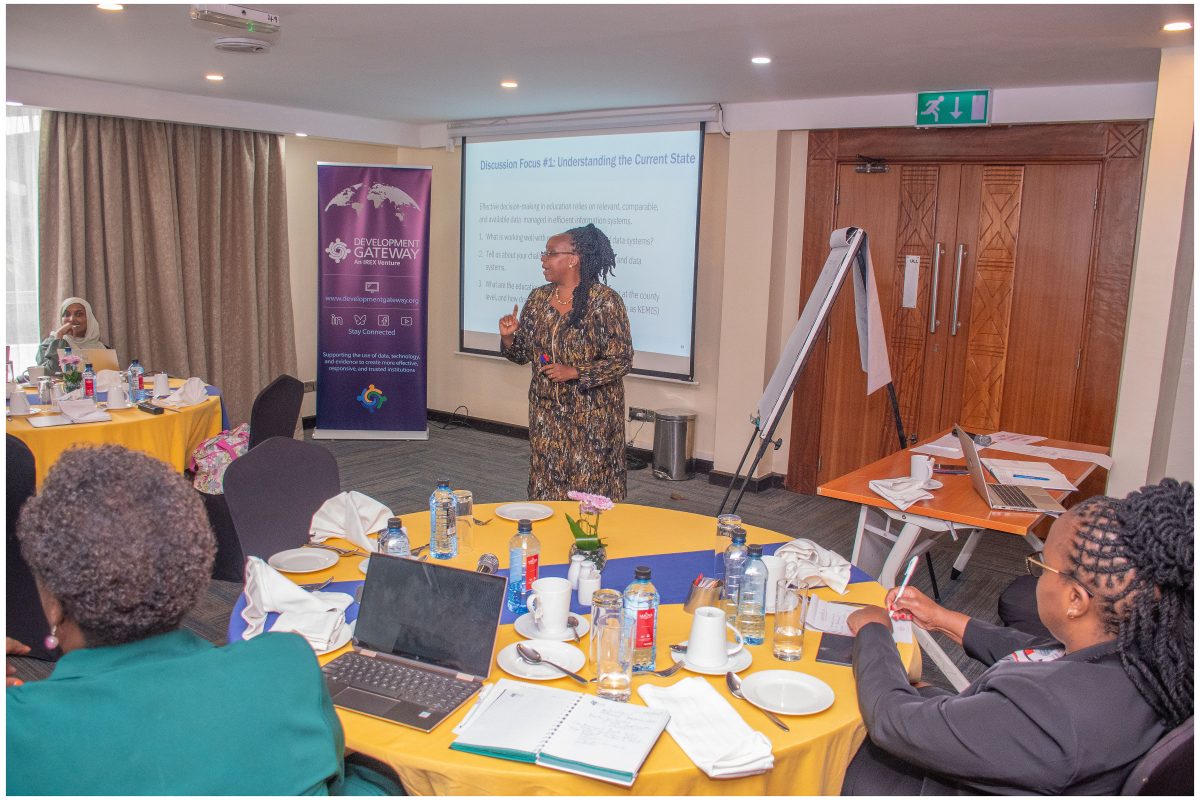
Challenge #3: Data Governance
Besides data collection and data hosting, a third major challenge we’ve seen during our work in the education sector is related to data governance. When talking with education experts from Kenya, Senegal, and Europe, we find that a common trend in the conversation is the underutilization of human resources dedicated to data processing and analysis, which inhibits data quality assurance and the effective use of data for decision-making.
Through our work in Hewlett 1.0, for example, we discovered that in one Kenyan county, there was only one data official working on data analysis for the entire county. These limitations in human resources exacerbate existing data quality and access challenges and can result in these challenges not being prioritized at a management level.
The lack of resources and the scarcity of officials dedicated to data governance is a challenge we have encountered in a wide variety of sectors, particularly those that deal directly with governance or public infrastructure. In the agricultural sector, for example, the aLIVE team faced data governance challenges related to understanding the existing data management practices prior to the program’s initiation. The team found that these data practices were often not documented and rather relied on the memory of staff members to inform others about them. Due to staff turnover and the volume of systems, each with its own governance standards, much of this information was either lost or convoluted in such a way that understanding the overarching data governance landscape was a significant challenge.
While it may be challenging to gain a full image of the data governance structures in place, it is still vital to understand as much as possible what already exists in terms of data management, practices, and processes. It’s extremely rare for there to be “zero” data governance and, as such, the best practice is to document all you can of this foundational knowledge and build from there. This documentation not only helps to alleviate duplication but also builds buy-in for new practices among local system owners.
Moreover, we have encountered this challenge in our work over the years, providing the United Nations Children’s Fund (UNICEF) with data strategy services, supporting the development of their global data governance strategy. As part of this long-term agreement, we have focused on what responsibilities data stewards should have and the functions they need to fill across UNICEF and the overall UN system. This process has highlighted the challenge of data governance in education and how building up the “data savvy” capacity in staffing functions across all levels of an organization can help to solve it.
Lessons Learned: The people, rules, and procedures that govern the use of data across systems must be reviewed as thoroughly as the technical requirements. By clearly documenting the current state of affairs, we can define the “unwritten” rules of data governance and streamline the integration of data into everyday decisions.
Charting a Path Forward in Digital Solutions
As we continue our work in health, agriculture, and education, we’ll continue to aggregate our lessons learned on data collection, data hosting, and data governance. Although there are common challenges across sectors, we see how a clear understanding of the data landscape, including what data governance practices and processes are in place, can inform the successful integration of new systems for many years to come.

Economic Toll of Tobacco-Related Diseases in Kenya: New Research Findings
Development Gateway: An IREX Venture (DG) is pleased to announce the publication of a research manuscript on the Economic Costs of Tobacco-Related Illnesses in Kenya. This research was carried out as part of the Tobacco Control Data Initiative (TCDI) activities in Kenya and is part of a broader report on Morbidity and Mortality from Tobacco Use in Kenya. Data from this research is available on the TCDI Kenya dashboard, which aims to supply decision-makers in government, members of civil society, and academia with improved access to country-specific data to better inform tobacco control policy.
Published in August 2024 in the Tobacco Use Insights journal, this is the third of three manuscripts that seek to break down the research report’s findings. The first, published in November 2023, explored the prevalence, patterns, and factors associated with tobacco use among patients with tobacco-related illnesses (TRIs), such as cancers, cardiovascular disease, chronic respiratory disease, and diabetes. The second, published in July 2024, focused on Mortality from Tobacco Use in Kenya. You can access its accompanying blog post here.
This blog highlights some key findings in the manuscript, based on the research carried out in Kenya from 2021-2022, estimating the direct, indirect, and ultimately economic costs of tobacco use for the period studied.

Why research on the economic burden of tobacco use in Kenya?
Indirect and direct medical costs of treating TRIs can place a significant economic burden on societies through healthcare and productivity losses. This is especially true for low- and middle-income countries (LMICs), which bear the brunt of the global tobacco crisis, accounting for a staggering 80% of tobacco-related deaths worldwide. As a result, assessing the economic impact of tobacco consumption in LMICs is crucial for shaping effective tobacco regulation and policy. However, this has been understudied in Africa, and the data that is available remains scant. In Kenya, estimating the economic costs of tobacco use is imperative to making informed, evidence-based policy decisions.
This manuscript not only reveals the direct financial burden of tobacco use but also offers a solid foundation for defining the necessary policy actions to address its harmful health and economic consequences. Additionally, it highlights the far-reaching effects of exposure to secondhand smoke for non-smokers, responsible for an estimated 1.3 million deaths annually worldwide. Barring effective tobacco control interventions, LMICs will be up against higher tobacco-related healthcare costs, placing even more strain on already overwhelmed healthcare systems.
Key Findings from the Research
The estimated healthcare costs linked to tobacco use in Kenya are an alarming US$396.1 million (approximately 53.4 billion KES). Among the tobacco-related illnesses (TRIs) studied, myocardial infarction (heart attack) was the leading cost driver, accounting for US$158.7 million (approximately 21.42 billion KES). Following that, peripheral arterial disease and stroke each contributed US$63.7 million (approximately 8.74 billion KES) and US$44.7 million (approximately 6.02 billion KES) in healthcare expenses, respectively. A significant portion of these costs -over 90% – is driven by the expense of medications required to manage these conditions.
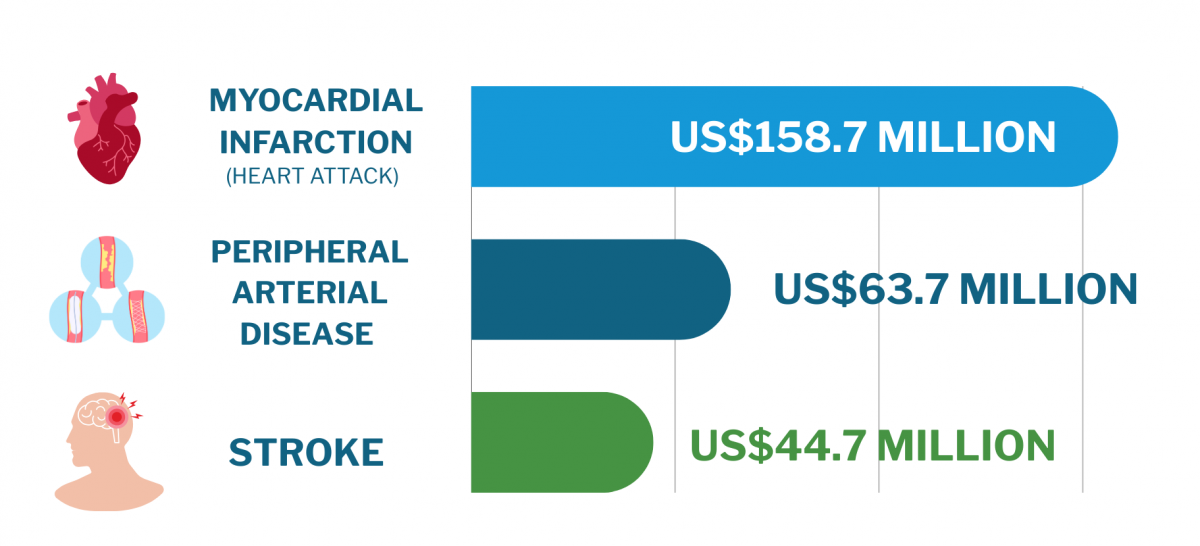
Regarding productivity losses due to tobacco-related illnesses, the costs range from US$148 (approximately 19,980 KES) per person to US$360 per person (approximately 48,600 KES), making up between 27% and 48% of the total economic burden. Productivity losses from the diseases ranged between US$148 (approximately KES 19,980) and US$360 (approximately KES 48,600), accounting for 27% to 48% of the economic costs.
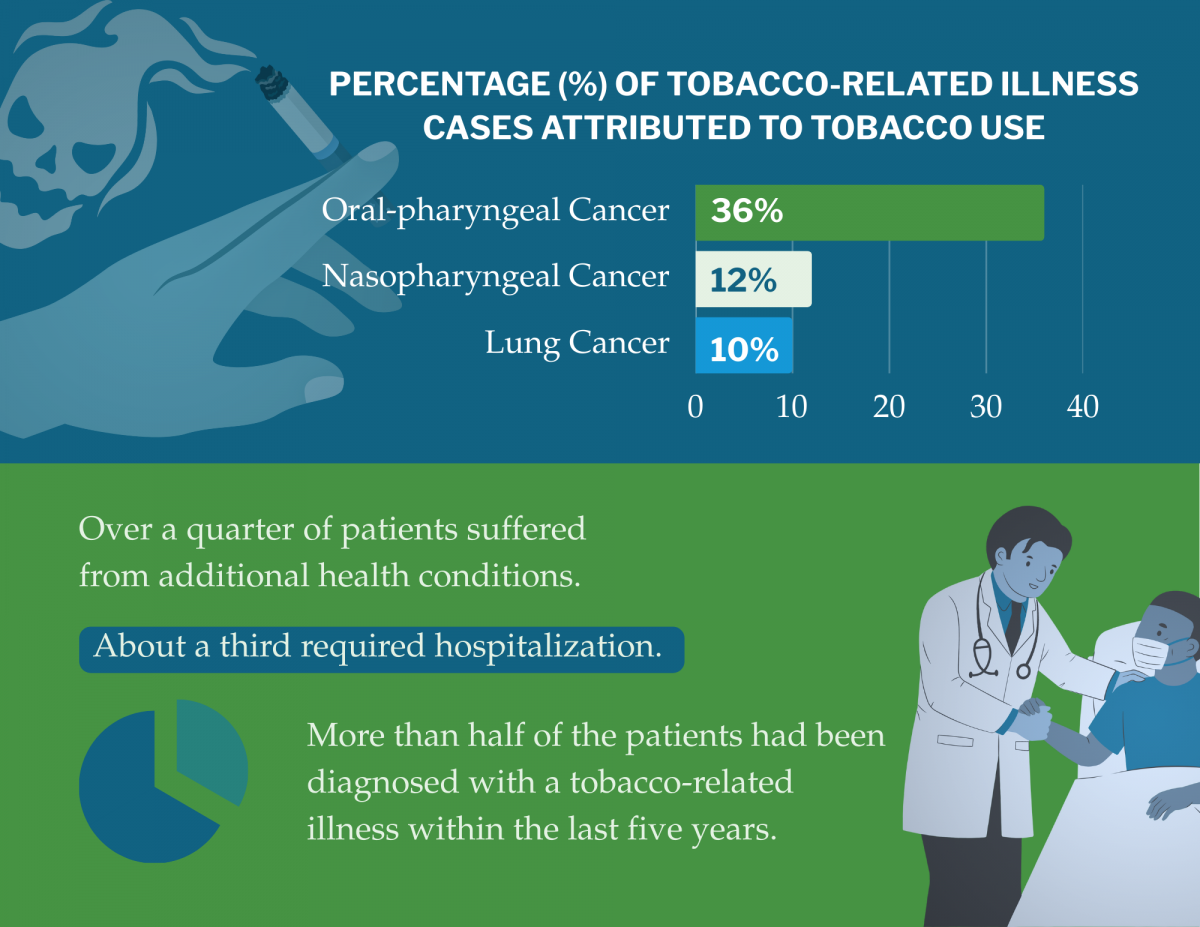
In terms of healthcare costs per case, lung cancer was the most expensive, costing US$23,365 (approximately KES 3,150,275) per case, followed by oral-pharyngeal cancer at US$7,637 (approximately KES 1,031,995), and laryngeal cancer at US$6,922 (approximately KES 933,470).
In 2022, the tobacco industry in Kenya generated $7.35 million in revenue, representing 7% of the country’s GDP of US$105 billion. However, the economic cost of tobacco use – just for the illnesses included in the study – accounts for more than 34% of this revenue. In other words, the financial toll of tobacco use in Kenya ranges from US$544.74 million (approximately KES 73.5 billion) to US$756.22 million (approximately KES 102.1 billion), while the tobacco industry’s contribution to the country’s GDP is much smaller at US$252.93 million (approximately KES 34.1 billion).
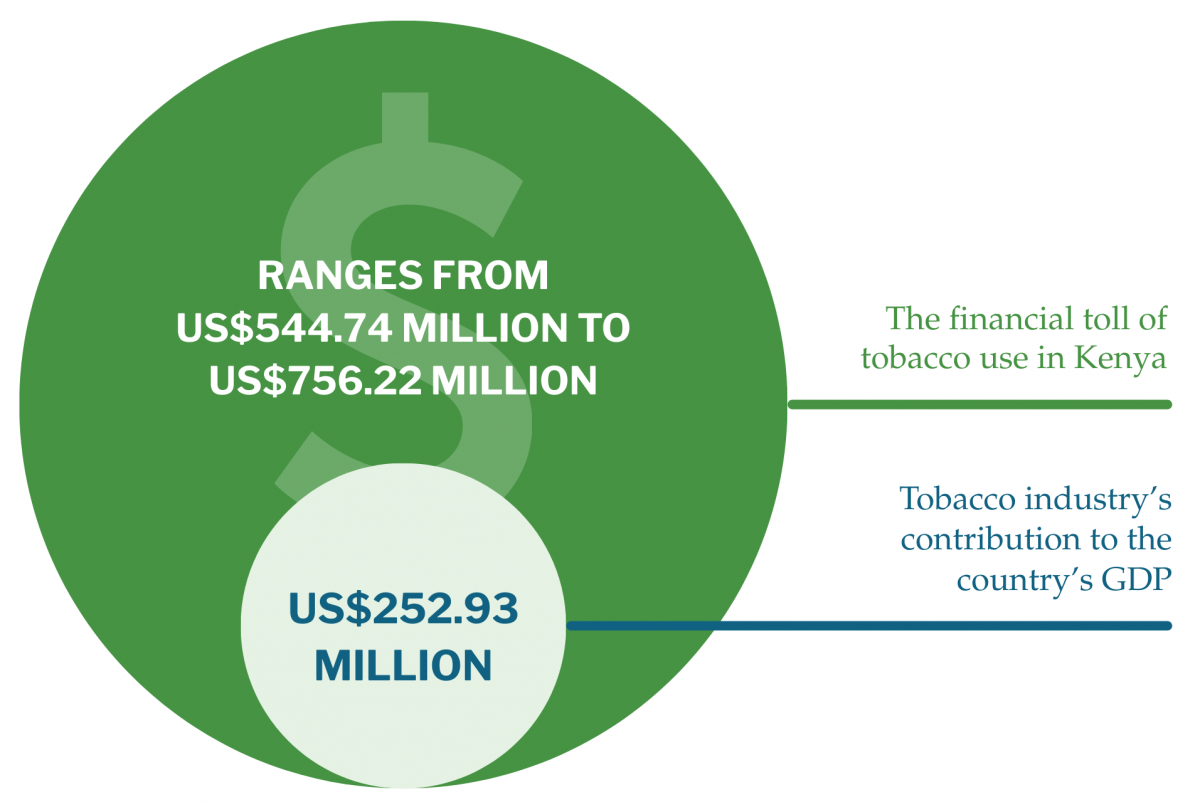
When comparing these figures, tobacco use results in a net loss to the economy of between US$291.8 million (approximately KES 39.4 billion) and US$503.3 million (approximately KES 67.9 billion) each year. This means that for every dollar the tobacco industry earns, the economy loses between KES 297 and KES 405 in healthcare costs and lost productivity, illustrating a poor return on investment.
The analysis further shows that treating tobacco-related illnesses (TRIs) in Kenya is an enormous financial burden on the healthcare system, with total treatment costs estimated at US$2.8 billion (approximately KES 378 billion). Of this, US$396.1 million (approximately KES 53.4 billion) is attributed explicitly to tobacco use, accounting for 14% of the overall costs of managing these diseases. In terms of comparison, the economic burden of tobacco use in Kenya is somewhat less than in South Africa, where the cost is US$2.88 billion (approximately KES 388.8 billion), but more than in Uganda, where the cost is US$126.5 million (approximately KES 17.1 billion).
These differences can be attributed to varying smoking rates and the prevalence of tobacco-related illnesses in each country.
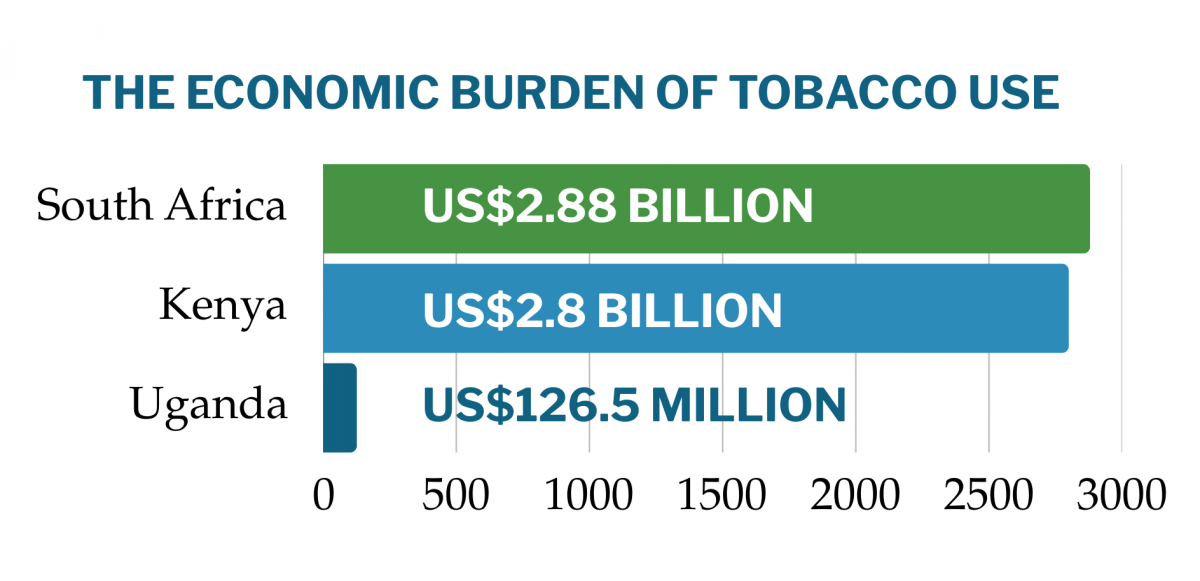
Implications for Policy
To address the economic and health impacts of tobacco use in Kenya, several key policy recommendations can be made:
- Strengthen Tobacco Control Laws: Implement comprehensive tobacco control legislation, enforce existing laws rigorously, and increase taxes on tobacco products to make them less affordable and accessible.
- Promote Cessation Programs: Advocate for the introduction of more support services for people trying to quit smoking, as well as monitor the tobacco industry’s activities to ensure they comply with existing regulations.
- Engage Stakeholders and Raise Awareness: Build stronger collaborations with relevant stakeholders, run public awareness campaigns to educate people about the dangers of tobacco use, and encourage policymakers to prioritize tobacco control on the national agenda.
- Capacity Building for Enforcement: Invest in strengthening enforcement mechanisms and provide training for healthcare professionals on effective tobacco cessation strategies.
- Leverage International Partnerships: Work with international organizations to tap into their expertise and resources, ensuring the successful implementation of tobacco control measures.
- Adopt Global Best Practices: Align local policies with global best practices and evidence-based strategies to enhance tobacco control efforts in Kenya.
- Use Research to Inform Policy: Use ongoing research and data to develop evidence-based policies supporting tobacco cessation and reducing tobacco-related harm.
By adopting these policy measures, Kenya can mitigate the significant economic burden of tobacco use and work towards better health outcomes for its population.
If you would like to learn more about TCDI and explore country-specific data, kindly visit www.tobaccocontroldata.org.
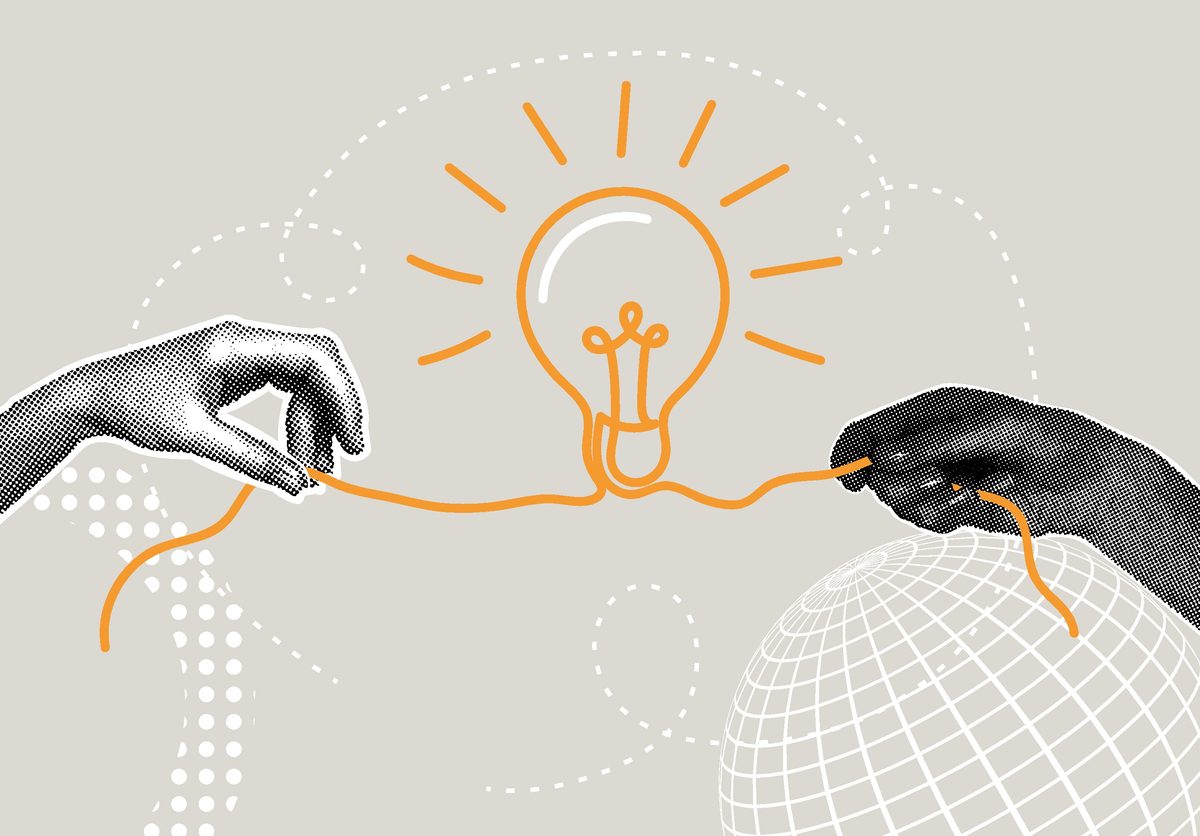
The Data Crisis Following USAID’s Withdrawal: Opportunities to Reimagine Data Systems
The immediate effects of cuts to USAID are becoming clearer, with the US largely absent from the international response to the Ebola outbreak in Uganda, the devastating earthquake in Myanmar, and the humanitarian crisis in Sudan. While the direct impacts of these cuts are making headlines, there is also a less visible, systemic consequence that could undermine development and humanitarian efforts long into the future: the destabilization of the data ecosystems that underpin global health, education, nutrition, agriculture, water, and sanitation services.
For decades, USAID and other US government funding have supported data used around the world. This includes routine survey data collection through programs like the Demographic and Health Survey (DHS), which operated in more than 90 countries to understand local and global trends, sophisticated satellite-based early warning systems for famine and disease outbreaks, and perhaps most critically, support to core administrative data systems used by government ministries to plan, budget, and target services. As country governments and their international development and philanthropic partners plan for a new development landscape, they will need to quickly identify and effectively fill these alarming gaps.
Beyond the immediate impacts of cuts on data for service delivery, budget planning, policymaking, and emergency surveillance, the abrupt termination of USAID funding is also putting at risk a promising trend toward the modernization of data systems as countries look ahead to digital transformation, digital public infrastructure, and AI readiness.
The twin crises of data and digital systems
Digital and AI technologies offer huge potential for increasing efficiency at a moment when country leaders must achieve more with fewer resources. The ability to better deliver public services through digital and AI technology depends on the successful collection, sharing, and management of data across and beyond government. Without investment in country data systems, there will be limited data to power AI solutions and drive the longer-term digital transformation of public services.
The immediate effects of the funding freeze (and subsequent terminations of programs) on the digital systems underpinning key service delivery are starkly demonstrated in Kenya. A March 28th, 2025 letter from civil society and community representatives to the Office of the Data Protection Commissioner (ODPC) states:
We…would like to draw the attention of the ODPC to reports that the funding freeze from the United States government has led to the inability by the Government of Kenya, specifically the Ministry of Health, to control, process and/or even access health data contained in the Kenya Electronic Medical Records (Kenya EMR). The Kenya EMR is an electronic medical record (EMR) system that has been used by the Ministry of Health to manage patient data in Kenyan public health facilities. We have multiple reports that public health facilities nationwide (where the systems are in use) have resorted to use manual registers.
Kenya’s EMR system went dark following the Stop Work Orders because, although the system is managed by the Kenyan government, it was physically hosted by a server operated by a USAID-funded implementing partner.
This presents a real risk to the progress made in the digital transformation of Kenya’s health care system, threatening the ability of healthcare workers to deliver life-saving care. Our partners have informally highlighted similar risks playing out in countries across the region, including agricultural data systems in Ethiopia, health systems in Ghana, and critical health commodity supply chain systems in Tanzania.
These twin crises – a halt to data collection and the undermining of digital systems – reveal existing inefficiencies and instabilities in how data is collected, managed, and shared both within and between countries. This moment also provides an opportunity to reimagine some long-standing problems in how governments and donors think about data and digital investments. There is a chance now to strengthen country ownership and investment in data systems, to reduce fragmentation, and to create more sustainable data systems. And as digital innovations like AI make data even more influential than before, it stands to transform public services and optimize – or even revolutionize – their delivery.
Reshaping digital and data policy for the long term
The seemingly quiet collapse of data systems is alarming and poses major short-term and longer-term challenges. It also reinforces the downsides to the previous donor-funded approach to data, which often led to fragmented sets of data systems, each for its own purpose. There has been insufficient attention to interoperability or an overall comprehensive and efficient architecture, and no clear sustainability model beyond additional donor-funded projects. As countries respond to the new development funding reality, we anticipate governments will be forced to adapt in ways that reshape digital policy, financing, and implementation. This adaptation offers the opportunity to reimagine data ecosystems that are owned by local actors, sustainably financed, and poised to unlock new opportunities for transformation:
- Now is the time to increase emphasis on data sovereignty, data localization, and data protection, including close attention to where systems are hosted and how their availability is funded and guaranteed. Decisions that lead to “good” digital public infrastructure that prioritizes “future-proofing” are notoriously difficult, as described in Chapter 4 of DG’s “Demystifying Interoperability” publication. However, these decisions, particularly in times of resource scarcity and crises, can be made by prioritizing political consensus around sustainable digital systems and “good” practices.
- Sustainable data systems will require more domestic resources and investment in data. The abrupt halt of USAID funding for data systems underscores that aid-funded models are not fully sustainable. But scarce domestic funding and other priorities have blocked the pathway to full country ownership. Initiatives like the UN/World Bank ‘Power of Data’ coalition are bringing together donors, multilaterals, and governments at the national level to strengthen political support, agree on priorities, and commit to funding data systems in line with national growth and development strategies.
- New investors and funders can maximize returns by funding systems and reducing fragmentation. The current crisis reveals how the fragmentation of data systems has weakened their resilience, as a lack of interoperability and failure to properly integrate digital and data systems have created missed chances to innovate and modernize. Funding that focuses on strengthening the whole system to support innovation can accelerate the adoption of new approaches and support private sector innovation.
The role of development partners
Beyond the immediate need for resources to support continuity of core systems like Kenya’s EMR, the fallout from the termination of USAID funding demonstrates the need for a new strategic approach to partnership. These partnerships need to be grounded in country ownership, in turn requiring governments to prioritize, resource, and maintain critical digital and data systems, and requiring development partners to ensure they align their contributions with these priorities.
Digital transformation frameworks and roadmaps used to guide donor investments must be pragmatic and focused on the implementation and integration of core digital and data systems, both new and legacy systems.
Philanthropic and development partners need to make a concerted effort to support the rapid creation of country digital and data strategies for transition to true local ownership that emphasize:
- Domestic resource mobilization
- Data governance and interoperability of core systems
- Technology strategies that streamline the plethora of existing digital and data systems to align with the national strategy
- System ownership, sustainability, and localization.
How these elements are implemented also requires intentionality. Data systems can and should be financed through diversified models that blend public, private, and philanthropic investments. Diversified funding mechanisms are possible, but the philanthropic and development community beyond the US Government needs to be strategic in their actions and partnership structures in how they act as a partner to support countries in making these transitions. Aid and philanthropy play an important role in de-risking investments in data, allowing for multiple building blocks of funding to deliver an intentional ecosystem approach to funding data systems.
With a country-owned strategy in place that strictly prioritizes the function, data sharing, and use of core systems, governments can direct traffic and create new funding models for data, as new partners can pay for aspects of the system that match their needs. We saw this take shape in our VIFAA program, where private sector stakeholders in Nigeria co-invested $120k to ensure state-disaggregated data on fertilizer availability and use. The private sector should not be expected to fund everything (and often cannot, due to antitrust laws), but it is an under-utilized source of both funding and innovation in government digital transformations.
The way forward
In the immediate term, supporting the critical services whose delivery was disrupted by the US withdrawal must be the development community’s priority. However, the medium- to long-term implications of data system failures extend beyond immediate disruptions; they threaten progress toward equitable, effective, data-driven delivery and readiness for future innovation.
As we assess what should be preserved in the wake of mass funding cuts, there is a clear role for pragmatic investments in digital public infrastructure built on core data systems, but this time with countries in the lead and stronger coordination and alignment among development partners.

Building a Sustainable Cashew Sector in West Africa Through Data and Collaboration
Africa is a leading producer of raw cashew nuts (RCNs), accounting for a significant portion of global production. In 2023, West Africa’s cashew harvest reached a record-breaking 3 million tons, marking a 15% increase from the previous year. Côte d’Ivoire stands out as the world’s top producer, with a crop of approximately 1.2 million metric tons. Other major producers in the region include Nigeria, Ghana, and Benin.

Cashew farming in West Africa is predominantly carried out by smallholder farmers, with over 2 million farmers contributing to more than 30% of the global supply. The profitability of cashew farming varies based on factors such as market information, yield, market access, and global prices.
As part of the United States Department of Agriculture (USDA)’s Food for Progress PRO-Cashew project for West Africa, Development Gateway: An IREX Venture (DG) collaborated with Cultivating New Frontiers in Agriculture (CNFA) to develop a data collection and analysis platform. This platform aims to enhance cashew productivity and competitiveness by supporting informed decision-making across the value chain in Côte d’Ivoire, Benin, Burkina Faso, Ghana, and Nigeria. Informed decision-making can help gain higher productivity through increased yields per hectare and reduced post-harvest losses, improve competitiveness through high-quality cashews meeting global standards, and help create more jobs.
The project came to an end in August 2024 after four years of working with government agencies, producers, traders, processors, and development partners in the five implementing countries to co-create an online tool aimed to inform, support, promote, and strengthen Africa’s cashew industry.
This blog outlines some of the key project highlights, including some of the challenges we faced, lessons learned, success stories, and identified opportunities for a more competitive cashew sector in West Africa.
Building the Cashew-IN Platform
PRO-Cashew aims to address the underlying issues of competitiveness in West Africa’s cashew sector, the inconsistent cooperation amongst regional policymakers, and the resulting trade impediments. The project identified, prioritized, and implemented strategic activities at different points of the cashew value chain to meet the unfulfilled needs of the target group beneficiaries more effectively. To incentivize, strengthen, and empower cashew value chain actors with actionable data, CNFA and DG designed a cashew data collection and analysis system (Cashew-IN) to expand and improve existing data-sharing systems focused on cashew production, trade, and processing levels.
Cashew-IN aims to make data easier to use for better decisions and improved outcomes in the cashew market. To support these objectives, DG used its Custom Assessment Landscape Methodology (CALM) to identify gaps in existing data collection, storage, and analytical tools in the cashew sector, as well as key decisions and target “use cases” for the future users of Cashew-IN. These learnings guided the design of Cashew-IN, a platform that addresses production, processing, and trade themes through a suite of visual tools configured to monitor and track associated indicators.
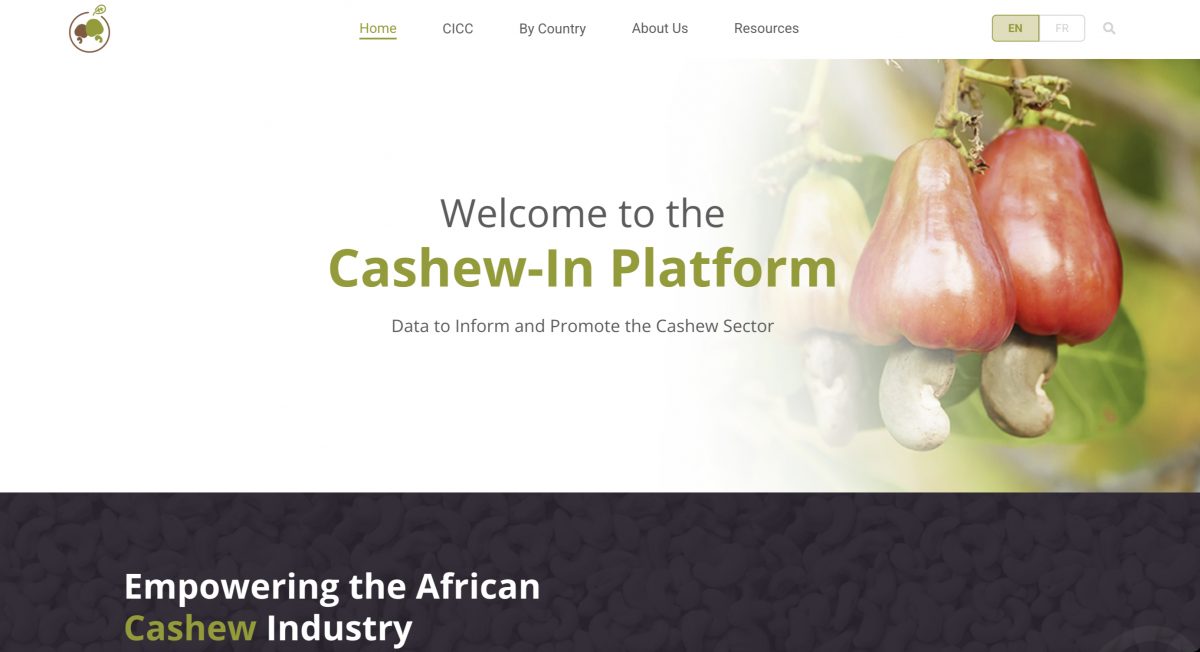
The Cashew-IN web application includes a user interface powered by WordPress, a user-friendly and intuitive software. It extracts its information from the embedded database configured to accommodate data starting from 2015 onwards. The data and information are entered by officially designated focal points by country. The Cashew-IN platform includes i) a regional dashboard managed by the International Cashew Council (CICC) and ii) country dashboards managed by an officially designated country administrator.
Sustainability Plan
As the Cashew-IN platform is regional in scope, DG has identified the International Cashew Advisory Council (CICC), an intergovernmental organization promoting cashew value chains, as a sustainability partner. The CICC comprises 11 countries, including the five Cashew-IN countries, and is decentralized at the level of each member country, with focal points per country from the cashew sector’s regulatory bodies or, failing that, the Ministry of Agriculture. CICC was selected to coordinate the operation of the Cashew-IN platform at regional and country levels through systematic and continuous data collection efforts leading to exhaustive and reliable data likely to inform decisions for a more competitive cashew sector.
To support ownership and sustainability at the country level, DG worked with national stakeholders from government institutions, producer associations, and the private sector to set up national committees responsible for managing their own version of the Cashew-IN platform in compliance with their laws and regulations governing data collection, ownership, and publication.
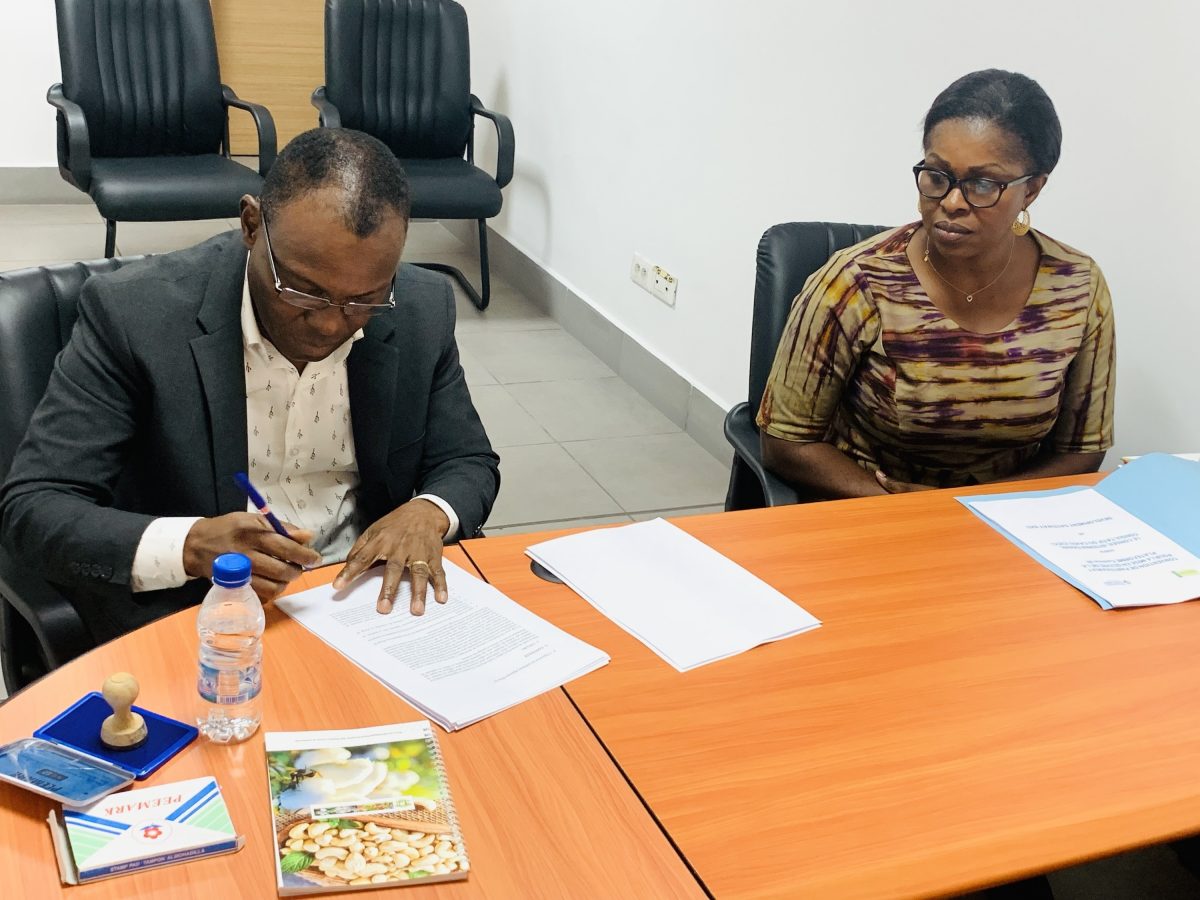
Lessons Learned & Stories of Change
First, the importance of data security and compliance with the countries’ data frameworks. One of the country’s Ministry of Agriculture was quite reluctant after the platform was first introduced, mainly because of data management and confidentiality concerns that emerged from a bad experience with a former partner. Understanding that Cashew-IN will be adapted to their national framework on data disclosure and that data will remain the property of the source helped alleviate their concerns and encouraged their involvement. The Ministry of Agriculture spontaneously joined the steering committee group.
Secondly, engaging and empowering national partners from the project assessment phase onwards – in line with the DG’s collaborative approach – facilitated the platform’s technical development and their buy-in and commitment. During the project’s closing workshop, one country’s representatives announced, as part of their ownership and sustainability strategies, the upcoming recruitment of an IT specialist who will be specifically dedicated to managing the Cashew-IN platform.
During the project’s closing workshop, one country’s representatives announced, as part of their ownership and sustainability strategies, the upcoming recruitment of an IT specialist who will be specifically dedicated to managing the Cashew-IN platform.
Finally, at the regional level, the CICC has taken ownership of the platform by providing two IT staff who have been trained to manage, update, and use the platform as well as adding new features. The Executive Director of the CICC also announced a plan to include other CICC member countries that are not involved in the Pro-Cashew-In programme and create a consultative committee made up of the three CICC technical committees (Production, Research, and Processing).
Appropriation and Capacity Building
DG conducted several sessions on platform use and management, data upload and configuration as well as maintenance of the platform. 56 country administrators and focal points of data-holding organizations from Benin, Burkina Faso, Nigeria, and the CICC have been trained to manage and use the Cashew-IN platform. 12 IT specialists from the same countries have also been trained to get familiar with the technologies used in the Cashew-IN platform, enabling them to support its development at the end of the project implementation. Following the technical training, the source code was shared with the IT specialists for exploration and modification.

Recommendations
To ensure greater ownership and sustainability of the platform and a significant impact on stakeholders (decision makers, producers, traders, processors, and academics), we recommend the following actions :
- Institutionalization of the platform with a view to systematizing data collection and updating the platform;
- Use of the platform as a reference for decisions taken in the cashew nut sector at both political and private sector levels;
- Involvement of trained stakeholders (IT specialists and focal points) in the maintenance and ongoing technical development of the platform;
- The gradual integration of other CICC member countries into the platform for better regional coverage.
What Comes Next
A few cashew-producing countries that were not included in the Pro-Cashew project expressed interest in joining the initiative (Mali, Senegal, Cameroon, Togo, etc.), an idea also supported by CICC, which expressed its interest in including other cashew-producing countries in the region.
From the program, we confirmed the necessity for DG to work closely with its partners to deliver outcomes that are both useful and meaningful. This project also revealed the importance of local capacity-building to manage the tool even after the project came to an end in August 2024.
Developing a digital solution can be a challenge, but including the beneficiaries from the onset and working closely with them throughout the project implementation has proven to be efficient as well as rewarding for the DG team.
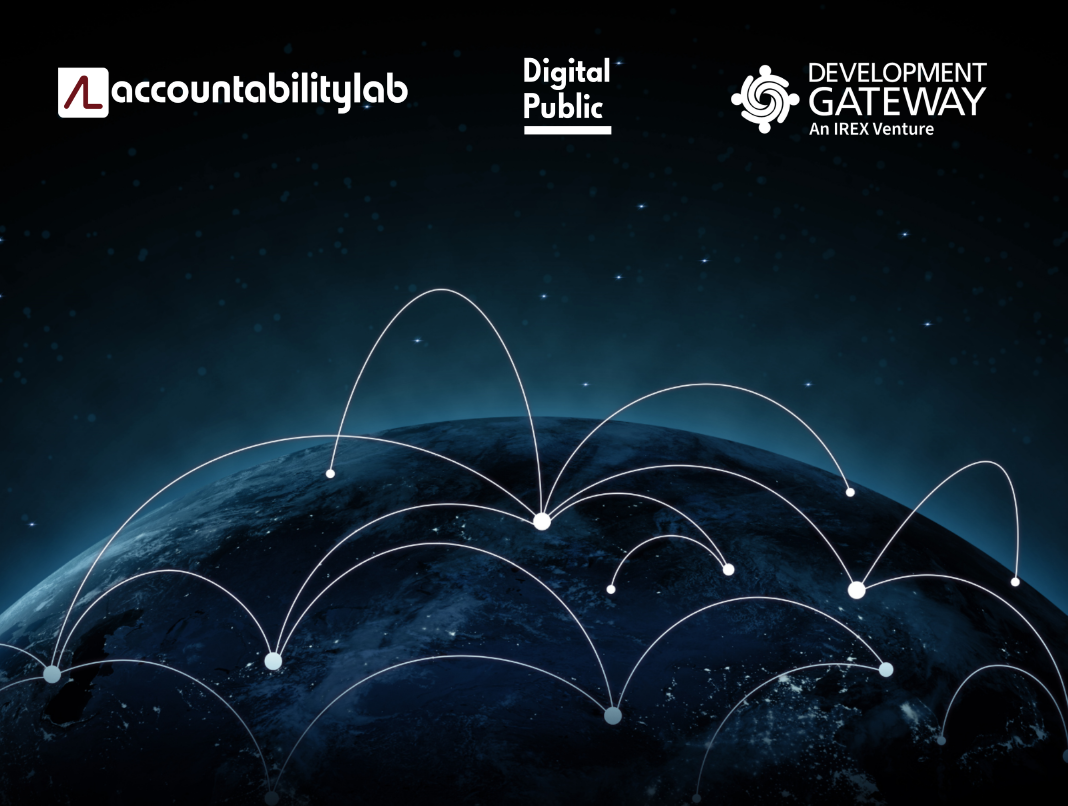
Launching a Partnership Matching Service for Nonprofits
This article was originally published here.
While a lot of us have talked about the potential, value, and – in some cases – need for more mergers and acquisitions in the non-profit space, recent events have made it clear: now is the time.
In the early days of these shifts, our team circulated a survey to civil society and international development organizations – and the resulting data, from more than 700 organizations, suggests that nearly 60% or organizations may close within the next 6 months. Given the recent stop work orders, contract and grant cancellations, and cascading effects of international civil society support shifts, a large number of non-profit, international development, and civil society organizations are confronting the need to re-organize.
Reorganizing is easier to say than do, though, and mergers and acquisitions in the nonprofit world are not nearly as common as they should be – but they can amplify impact and efficiencies. Strategic partnerships and mergers typically take 1-2 years to implement, but the hundreds of organizations facing newly shortened runways will have to act a lot faster if they are going to prevent the loss of significant amounts of knowledge, expertise and assets.
That’s why the teams at Accountability Lab, Development Gateway: An IREX Venture and Digital Public, partnered up: develop both a new toolkit, a partnership matching service, and professional support infrastructure aimed at assisting the organizations facing this challenge. While there’s no “one” name or type of transition that captures the reorganizing work ahead – from partnerships to mergers to legacy planning, our toolkit aims to de-mystify the processes and work that organizations will need to do to prepare for next steps. We are especially, and specifically, focused on helping mission-driven organizations navigate transitions in ways that preserve valuable teams, projects, technology, and knowledge.
While resources are important, we are dedicated to a more active approach – and so we’ve also launched a partner-matching service for groups hoping to bring on new initiatives and those who are hoping to help find their work find new homes. Already, we’ve had a number of promising discussions on how to get started, and heard the importance of centering trust, alignment, and proactive engagement. Designing a partnership or organizational transition is about identifying, articulating, and committing to practical, operational efforts to invest in a shared vision. The exercise has also shown how focusing on value proposition helps partners find alignments. Often, an inventory is a good starting point.
- Mapping what makes you unique
Consider the elements that differentiate your work or approaches. These may not be “things,” and instead be ways of doing things, captured in a toolset or service architecture, but they may be important to preserve and valuable to other organizations. Listing your team’s core skills and comparative advantages is also critical, along with ongoing lines of revenue. It’s helpful to think about the assumptions and dependencies required to keep the lines operating.
- Analyzing the landscape
Many organizations may have a shared definition of problems they are trying to solve but differ considerably in terms of their context and approach. Think about who is prioritising the impact or vision you hope to have and who is solving similar structural challenges in your field. Also, who has infrastructure and investments in your sector? Contexts adjacent to your work are likely to be aligned with it.
- Merger, partnership, or wind-down?
Consider several types of alignment based on mission, strategic approach, operations, technology, finances, culture, and politics. Each serves as a critical checkpoint to ensure that any merger or partnership enhances both organizations and sustains their shared goals. Thoroughly assessing alignment allows you to prioritize what’s important and avoid partnerships that might not align with your long-term vision.
- Finalizing solid partnership agreements
Once you identify the right partner, negotiations need to be handled carefully—ensuring all parties understand their roles, set clear expectations, and use frameworks that keep the process on track. Manage the tension between “fast,” “sustainable,” and “perfect.” The effort that makes the difference is being willing to engage in the messiness, build feedback loops and external legitimacy with stakeholder groups, and focus on sustaining the things that you prioritized in the beginning.
Overall, setting clear expectations and identifying deal-breakers early in the process will help safeguard each organization’s mission and values. Related considerations, such as digital development safety nets that consolidate and integrate infrastructures and preserve institutional knowledge and assets, must also be carefully outlined. This work ties into valuable, overarching objectives in terms of protecting and maintaining the global civil society ecosystem. Strategic partnerships and mergers of this kind offer a viable path for many organizations to sustain their impact amid unprecedented challenges.
*Is your organization considering a strategic partnership or merger of some sort? Accountability Lab, Development Gateway: An IREX Venture, and Digital Public would like to offer support for confidential conversations, documentation of needs, and identification of potential matches between organizations to fast-track collaborations.
Please complete the survey here or reach out to: Khadijah Chang khadijahc@accountabilitylab.org to discuss next steps.
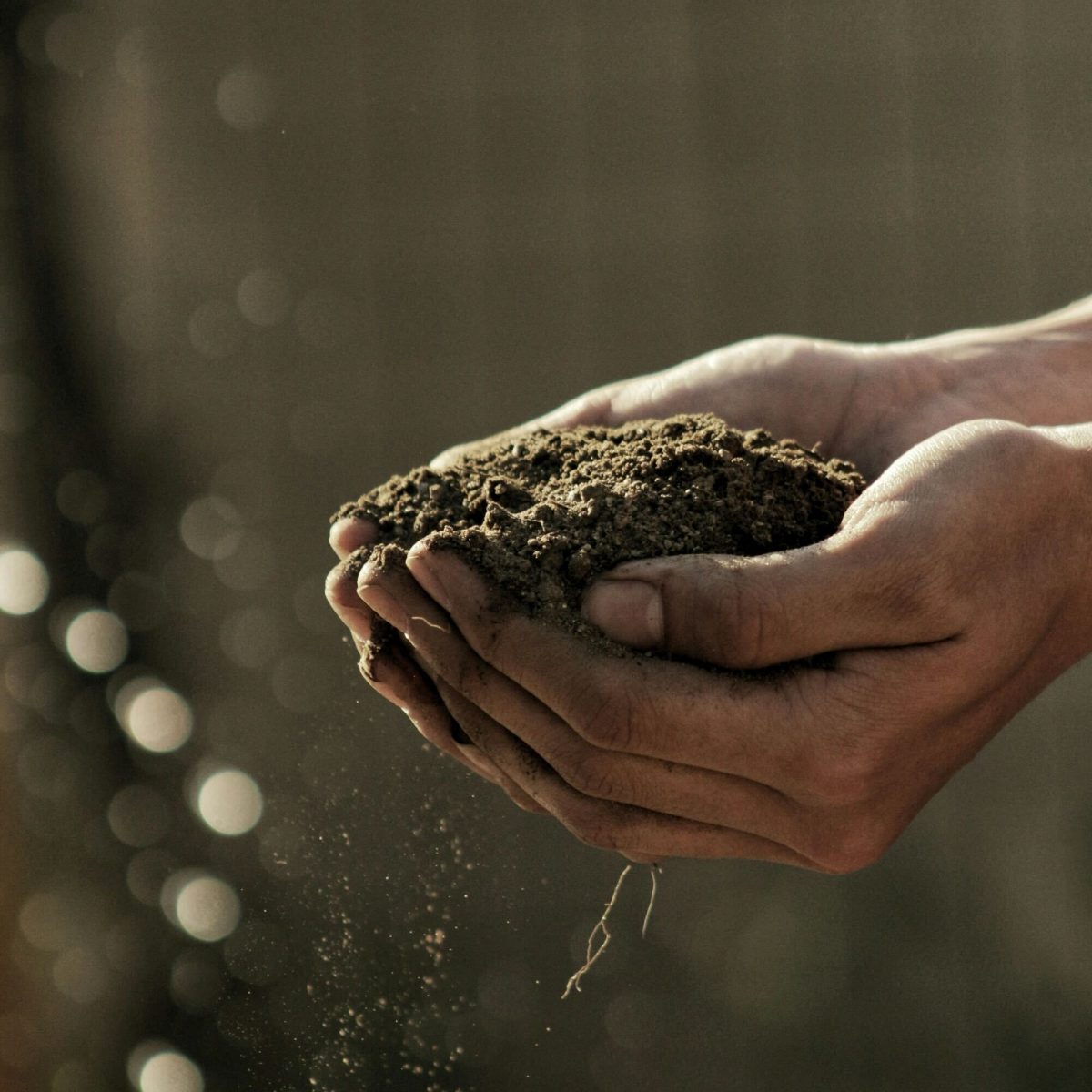
Unlocking Africa’s Agricultural Potential: Introducing the Soil Nutrient Roadmap
Food and nutrition insecurity are among our time’s most remarkable development challenges. In 2023, an estimated 846.6 million people across Africa faced moderate-to-severe food insecurity. Considering that this accounts for 58% of the continent’s total population, it is evident that immediate and long-term solutions are needed to strengthen food systems and address Africa’s food insecurity crisis.
The World Soil Charter emphasizes that healthy soil is fundamental to food security. However, soil degradation poses a major threat, with approximately 33% of global soils classified as moderately to highly degraded, 40% located in Africa. If left unaddressed, projections indicate that over half of Africa’s current arable land could become unusable by 2050.
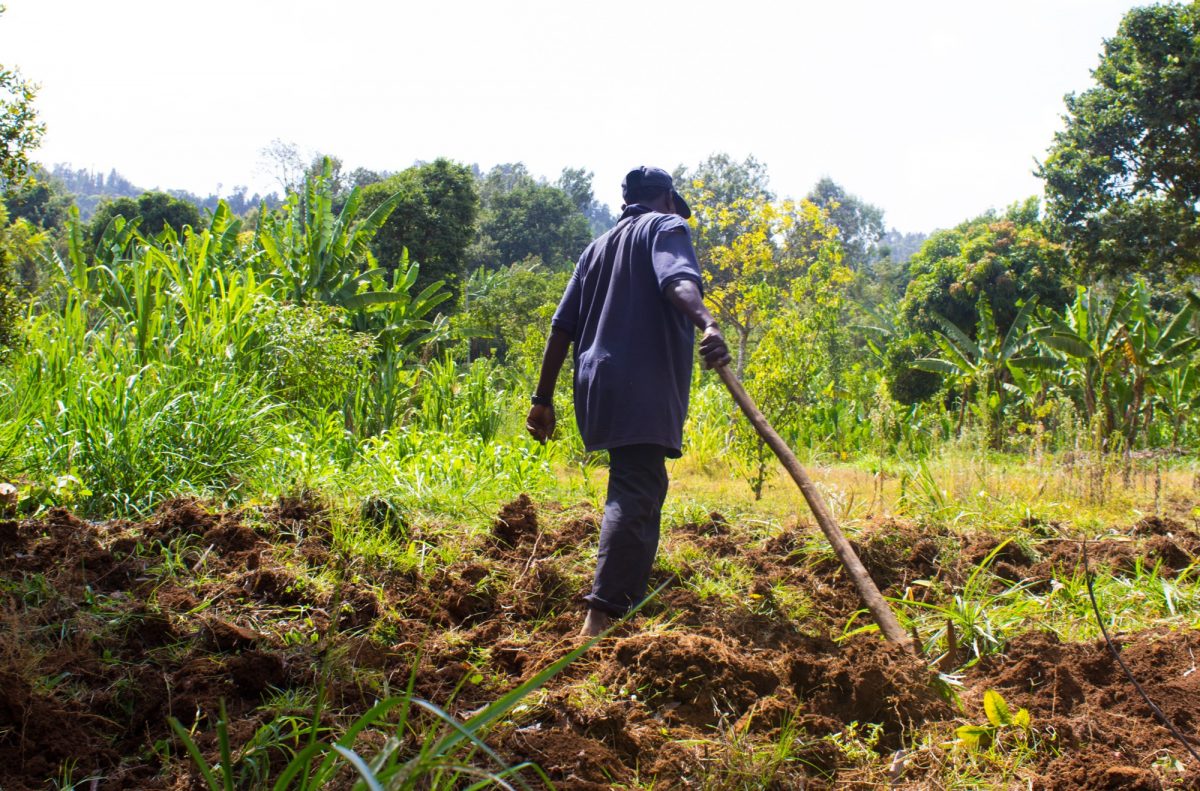
The Nairobi Declaration: A Continental Call to Action
In May 2024, the Heads of State and Government of the African Union met in Nairobi, Kenya, as part of the Africa Fertilizer and Soil Health Summit. With regenerating degraded soils and enhancing soil health labeled as essential for building resilient food systems, the Summit introduced a 10-year action plan to:
- Reverse land degradation and restore soil health on 30% of degraded soil by 2034;
- Triple domestic production and distribution of fertilizers by 2034 and
- Ensure that at least 70% of smallholder farmers have access to tailored recommendations & advisory services.
A significant challenge, however, is the lack of a comprehensive data framework for evidence-based national action plans and investment strategies, providing a crucial opportunity to leverage digital solutions and data-driven decision-making to inform national soil health strategies.
Introducing the Soil Nutrient Roadmap (SNR)
For over a decade, Development Gateway: An IREX Venture (DG) has been at the forefront of digital agriculture, leveraging agricultural data to support input monitoring, value chain analysis, and farmer-centric governance models. With funding from the Gates Foundation, DG is launching the Soil Nutrient Roadmap (SNR), a cutting-edge initiative using geospatial data to estimate current and future soil and crop nutrient requirements.
Building on the momentum of the Africa Soil Health Summit and the Nairobi Declaration, SNR aims to support African countries in designing national soil health strategies and investment plans. This initiative seeks to provide timely, relevant, and context-specific data for governments, the private sector, and agricultural stakeholders, enabling them to make informed decisions on soil health interventions.
To achieve this, SNR’s primary objective is to:
- Estimate current and future soil and crop nutrient requirements at national and subnational levels.
- Develop a roadmap to coordinate stakeholders and support investment planning.
- Enable governments, private sector actors, and implementing partners to collaborate on soil nutrient solutions.
- Provide decision-support tools for policy formulation and agricultural strategy development.
Designing and Testing the SNR Concept
In 2023/2024, with support from the Gates Foundation and Boston Consulting Group (BCG), in partnership with the International Fertilizer Association (IFA), collaborated to design a framework for national-level soil nutrient roadmaps. Ministries of Agriculture in Ethiopia, Rwanda, Kenya, Tanzania, and Ghana strongly supported the initiative, emphasizing its potential to transform fertilizer sectors and investment priorities in soil health.
Encouraged by the interest from a wide range of national and subnational stakeholders, the proof-of-concept has progressed into a 24-month acceleration phase led by DG. This phase will focus on developing an interoperable, data-driven platform to facilitate coordinated action and inform policy, regulatory, and investment decisions.
The project will be implemented over 2025–2026 in up to four Sub-Saharan countries: Kenya, Ethiopia, Tanzania, and Ghana. It will produce:
- The SNR framework: A suite of data, protocols, and models generating diagnostics to prioritize soil health interventions.
- A user dashboard: An interactive tool for country-level scenario visualization.
- Performance Indicators: Country-specific metrics for measuring impact and progress.
SNR will also investigate partnership models and sustainability strategies to ensure long-term impact and viability in different regions and chart a path toward the project’s localization.
The Roadmap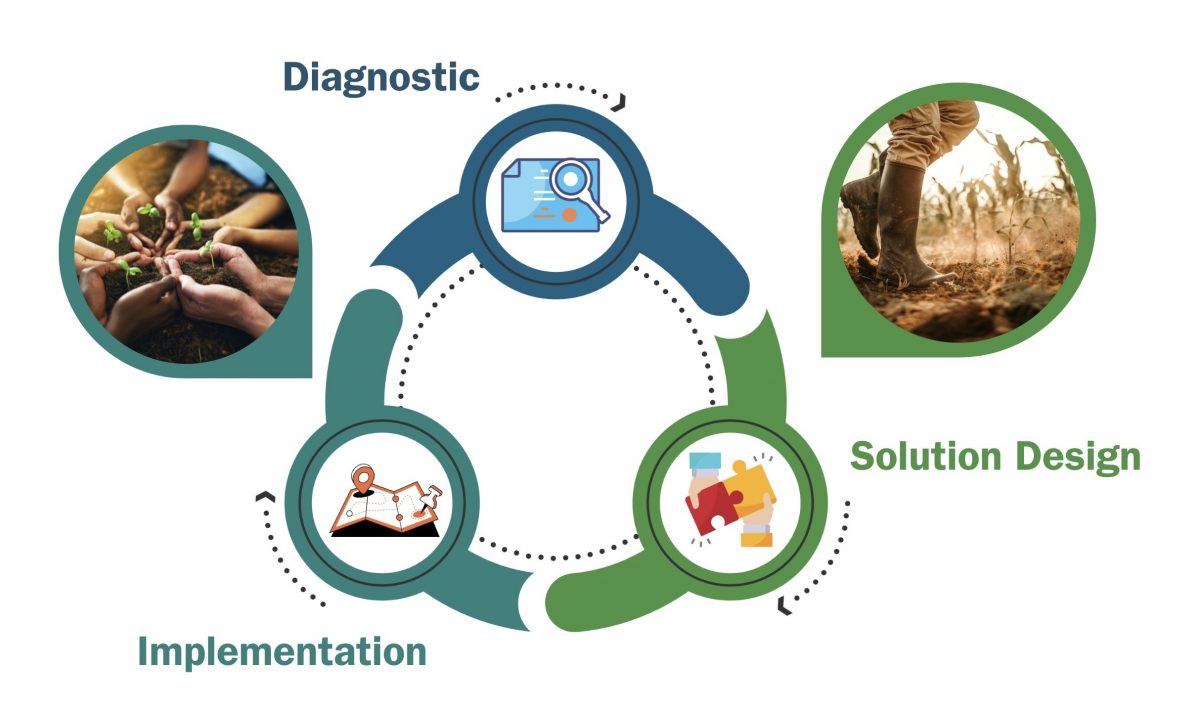
To address the trifold challenges faced by Africa’s agricultural sector of stagnating crop yields, degrading soil health and plant nutrition, and fertilizer dependency, SNR’s approach uses a 3-step journey:
1. Diagnostic Phase: Identifying Key Soil Health Challenges
This first phase of the roadmap aims to map out crop nutrient cycles, quantify indigenous nutrient supply, identify nutrient deficiencies, and determine key limiting factors such as soil acidity, erosion, and leaching. The insights will inform the setting of ambition levels and data-driven targets for national soil health strategies.
2. Solution Design Phase: Developing Targeted Interventions
Using diagnostic insights, SNR will design context-specific solutions, prioritizing key intervention areas, such as:
- Soil health & fertility practices such as intercropping and liming;
- Nutrient supply optimization;
- Water management;
- Seed improvement and
- Agricultural mechanization.
Each solution will undergo a simulation to determine its technical and financial requirements, the return on investment (ROI) assessment, and the development of regulatory, economic, training, and infrastructure support mechanisms.
3. Implementation Planning: Delivering Scalable Solutions
This final phase integrates prioritized solutions into an actionable national roadmap, detailing funding needs, governance structures, and implementation plans. This phase will also establish a Project Management Office to oversee execution and ensure measurable impact.
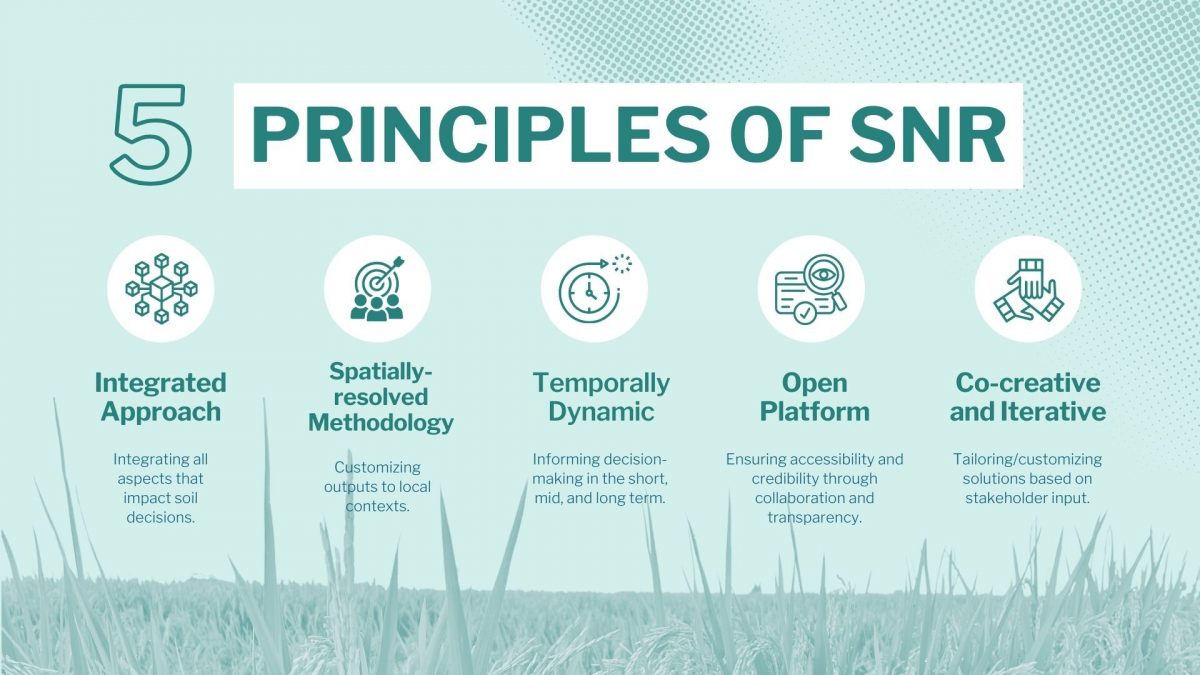
By addressing Africa’s interconnected agricultural challenges, SNR will empower governments and stakeholders with data-driven solutions to enhance soil health restoration efforts, increase domestic fertilizer production and distribution, improve smallholder farmers’ access to advisory services, and strengthen agricultural resilience against climate change.
SNR represents a critical opportunity to reshape Africa’s agricultural future, ensuring food security, economic growth, and environmental sustainability. As national soil health strategies take shape, the collaborative efforts of governments, private sector actors, and development organizations will be essential in realizing a resilient and productive agricultural landscape for future generations.
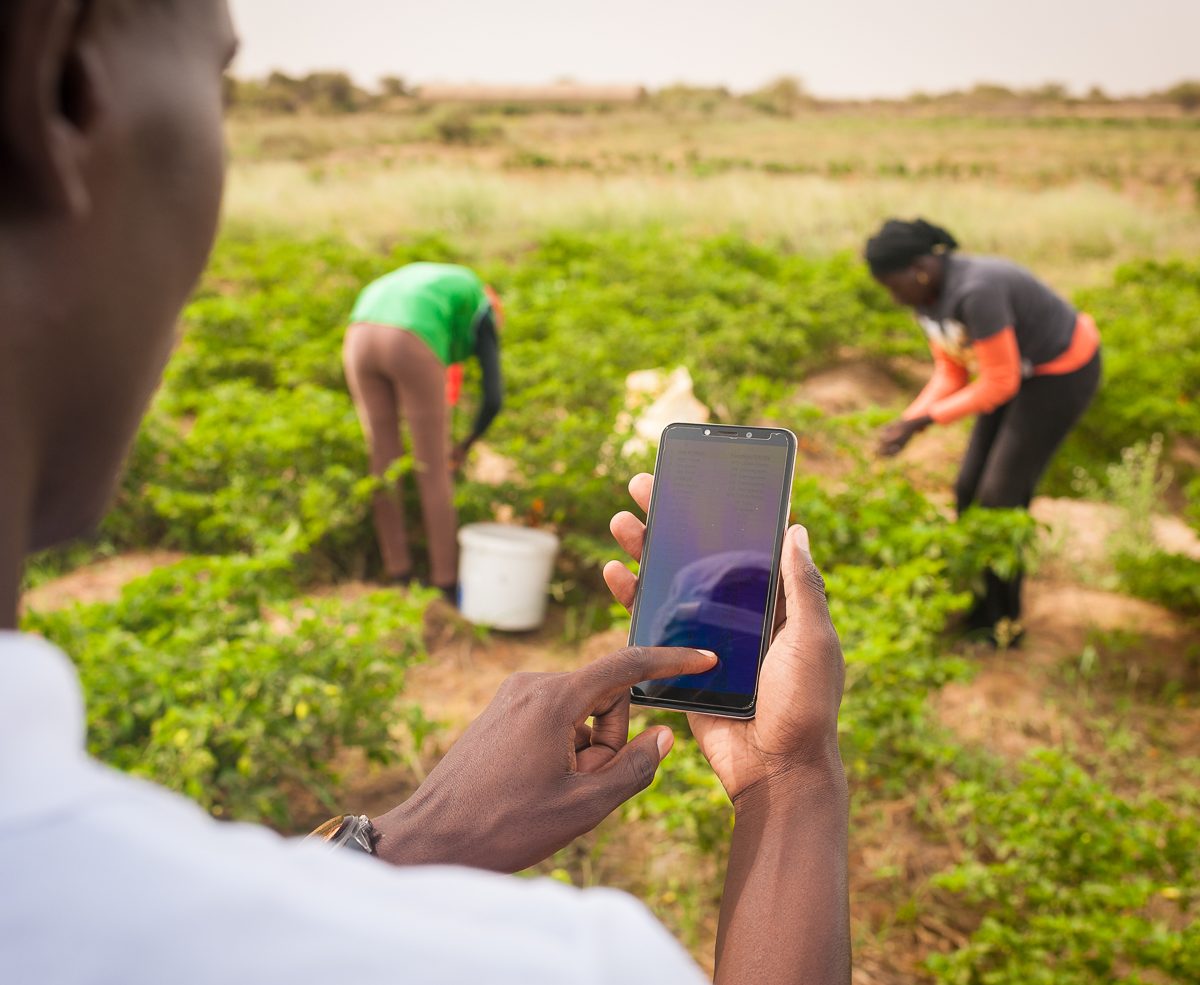
Digital Transformation for Public Value: Development Gateway’s Insights from Agriculture & Open Contracting
In today’s fast-evolving world, governments and public organizations are under more pressure than ever before to deliver efficient, transparent services that align with public expectations. While this increased pressure is largely due to the rapid digitization of public life, it is also the case that digital transformation is perfectly placed to be the ideal enabler of public value. When implemented correctly, that is.
In this blog, we delve into the key concepts behind digital transformation and how it can enhance public value by promoting transparency, informing policy, and supporting evidence-based decision-making.
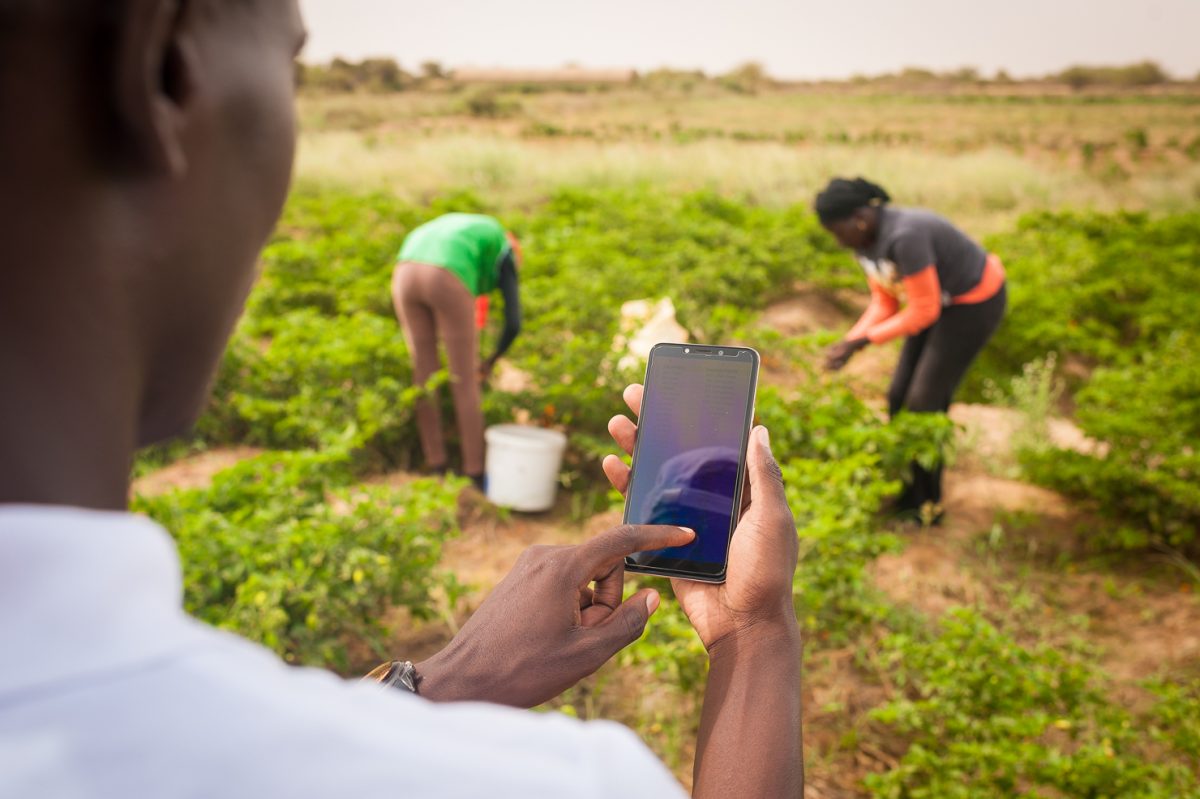
The Path to Enabling Public Value
Creating public value requires governments and public organizations to focus on results that align with the needs and expectations of the public, using resources wisely and maintaining accountability and transparency as they do so. Serving as a guiding principle for public managers and policymakers alike, aiming to add public value ensures that actions taken are about improving service delivery and attaining meaningful societal impact.
The concept of public value originated from the book “Creating Public Value: Strategic Management in Government,” written by Hauser Professor of Nonprofit Organizations, Mark Moore, in 1995. Moore’s theory on public value parallels the private sector’s customer-oriented approach, suggesting that public administrators should focus on how:
- Public activities create value for service users, relevant stakeholders, and general citizens;
- Public administrations can attract resources and leverage their authority and legitimacy; and
- Public administrations, institutions, and services can become more efficient and effective through developing service ecosystems and advancing the betterment of society.
Digital Transformation: Building a Strong Foundation for Value Creation
Digital transformation, the use of information and communication technologies to develop new capabilities in business, government, and society, goes well beyond mere automation. It involves adopting technologies to boost productivity, create value, and improve social welfare. Digital transformation offers significant opportunities to enhance public value, yet it also presents certain challenges that require strategic solutions to ensure it is implemented equitably and sustainably.
Data and digital technologies provide a pathway for governments to create public value through increased transparency and informed decision-making. By collating data, enhancing data systems and safeguards, and promoting cross-functional operations through interoperable data systems, we can establish a strong foundation for value creation in the public sector.
At Development Gateway, we focus on making data more usable and interoperable to drive better decision-making and transparency. Below are two of our programs where we helped achieve this, building a pragmatic foundation for value creation in the public sector.
Towards Interoperability and Transparency: The ‘a Livestock Information Vision for Ethiopia’ (aLIVE) Program
There has been increasing focus in the development space for the need to create seamless, integrated data ecosystems. Such ecosystems allow for the free flow of data between systems and across ministries and departments in the public sector while ensuring that said data remains secure. While system interoperability may be a key focus for governments aiming to improve efficiency and service delivery, this is often technically challenging for them to achieve.
In the aLIVE program, we are working with Ethiopia’s Ministry of Agriculture (MoA) and other stakeholders to digitize livestock traceability in the country, ensuring increased accessibility to and quality of livestock data. The initiative addresses challenges faced by farmers, policymakers, and stakeholders resulting from fragmented and inconsistent livestock information. By establishing a unified, accessible data platform, aLIVE supports better decision-making, enhances market access, and boosts the productivity and resilience of Ethiopia’s livestock sector.
aLIVE enables public value through digital transformation of the livestock sector in the following ways:
Improved decision-making: By providing reliable, timely livestock data, the program enables government agencies, NGOs, and farmers to make more informed, data-driven decisions. This facilitates better resource allocation and more effective, evidence-based policies.
Enhanced livelihoods: The program helps farmers improve their productivity and increase their income-generating potential by offering data-driven insights on market conditions, livestock management, and disease control.
Sectoral coordination: By integrating five legacy systems for livestock into a common data standard – the Livestock Information System (LIS) – aLIVE facilitates coordination among stakeholders in the livestock sector, fostering collaboration and reducing duplication of efforts.
Resilience and adaptation: Access to timely, readily available data is essential for livestock management, as it allows farmers to better adapt to challenges such as climate change and disease outbreaks, thereby enhancing the resilience of the livestock sector.

Improving Public Procurement Processes: DG’s Open Contracting (OC) Portal
Through our Open Contracting initiatives, we leverage data and technology to improve how governments manage public contracts. This, in turn, benefits citizens and promotes social and economic development, enhancing public value by increasing the transparency, accountability, and efficiency of public procurement processes.
An example of this is the county-level Open Contracting Portal we developed with the government of Makueni County in Kenya. This has since been designated as a digital public good (DPG) and added to the Digital Public Goods Alliance’s (DPGA’s) Registry, which ensures the OC Portal aligns with ethical, inclusive, and sustainable digital development principles.
The OC Portal is an interactive site providing detailed information about each step of the tender, award, and implementation process. It includes a series of charts that offer helpful data insights that can be utilized by civil society, the government, and the public. In addition to the public data available on the platform, government users can also access the Corruption Risk Dashboard – a tool that identifies tenders and awards based on specific metrics that indicate possible corrupt activities. The Portal also includes various ways in which to incorporate feedback from the public, including an SMS feature allowing for great accessibility.
The OC Portal exemplifies how digital public goods can enable public value by enhancing transparency and accountability while also reducing corruption, improving service delivery, and fostering economic growth.
…
While the concept of adding public value may seem abstract or theoretical, its true significance is to be found in its practical applications. Real-world efforts, such as promoting transparency, enhancing decision-making, and supporting sustainable development, demonstrate how public value can be effectively operationalized and turned into tangible outcomes that have a positive impact on society.
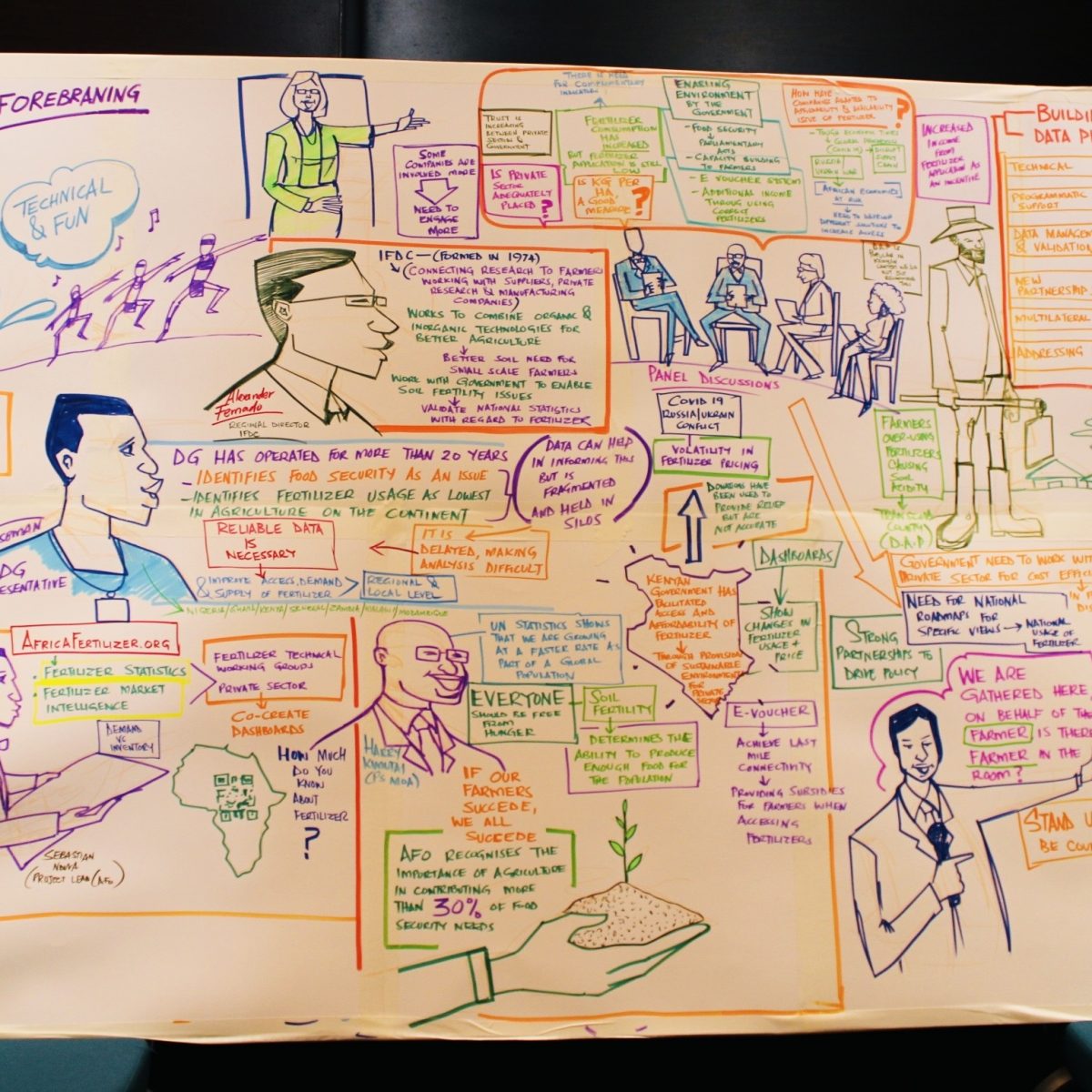
From Data Gaps to Impact: Key Insights from the VIFAA Program
Over the last six years, Development Gateway: an IREX Venture, together with its partners AfricaFertilizer (AFO), an initiative of the International Fertilizer Development Center, and Wallace & Associates, collaborated to implement the Visualizing Insights on Fertilizer for African Agriculture (VIFAA) Program, which created dashboards and tools that improve, manage, and visualize fertilizer data in Africa. Sub-Saharan Africa (SSA) has the lowest fertilizer usage in the world, which needs to be improved to replace soil nutrients lost through crop production. VIFAA partners have worked with the public and private sectors to strengthen data collection, analysis, and use, encouraging informed fertilizer use across the region.
In the program’s final year (2024), leading up to its conclusion in November, the team undertook a “program learning process” to reflect on outcomes, challenges, and successes through internal interviews. This blog captures five key learnings, which we hope will guide similar programs aiming to bridge data gaps in agricultural development.
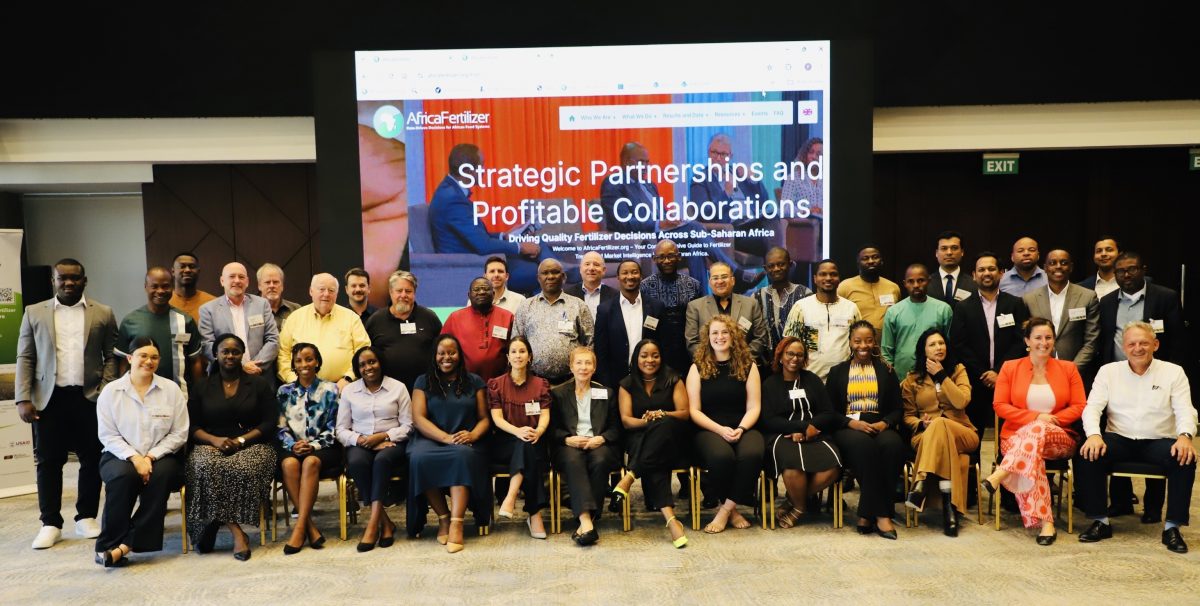
1. Participatory Approach as a Success Driver
VIFAA’s success is rooted in its participatory approach, involving stakeholders from the fertilizer sector from the outset of the program in each design and implementation phase. Rather than a one-size-fits-all solution, VIFAA emphasized co-design and customization to meet the specific needs of each of the 8 countries it supported. Fertilizer Technical Working Groups (FTWGs), organized by our local partner, AfricaFertilizer (AFO), facilitated this process. These groups brought together the private sector, customs, non-profit organizations, and the government to define relevant data indicators and validate data for each country’s dashboard.
The result is that each country’s VIFAA dashboard reflects local needs and realities. For instance, the Mozambique dashboard includes transit data visualizations to support fertilizer flow through trade corridors, while Nigeria’s dashboard displays locally blended NPK (nitrogen (N), phosphorus (P), and potassium (K)) data. This tailored approach, though resource-intensive, strengthened buy-in from diverse stakeholders, providing a robust foundation for the dashboards’ continued use and sustainability.
Lesson: Co-designing with end users is crucial, especially in multi-country programs, as it fosters stakeholder ownership and enhances program longevity.
2. Building Trust with the Private Sector
In the sensitive fertilizer sector, private stakeholders are often reluctant to share data. Despite this challenge, VIFAA included the private sector in its participatory approach. To address this, VIFAA used non-disclosure agreements (NDAs) to ensure privacy and build trust. This was key, particularly in countries like Nigeria, where private companies comprise a significant market share.
The successful use of NDAs encouraged strong private-sector participation, granting access to critical data and leading private companies to see the value of the dashboards, resulting in financial investments in their development.
Lesson: Building trust through confidentiality measures, such as NDAs, is one approach for securing private sector participation and access to sensitive data. This trust can also lead to long-term collaboration and financial investment in data tools and platforms from private companies.
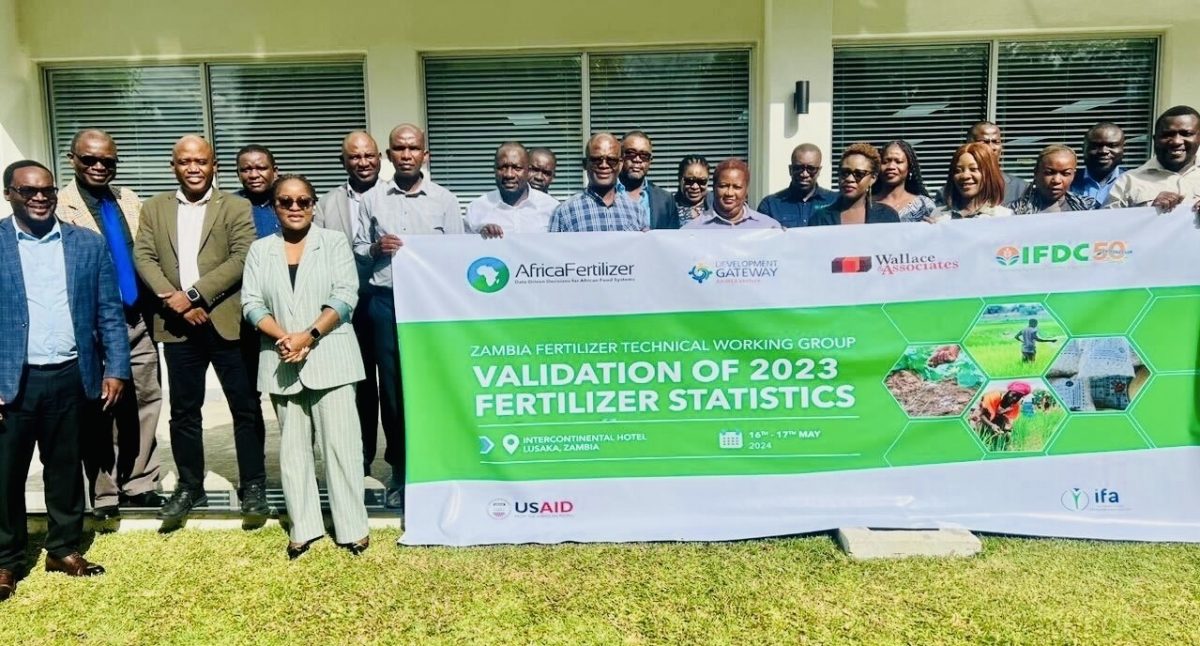
3. Adapting Engagement Strategies to Country Context
Each VIFAA country presented unique realities, shaped by its market structure and stakeholder landscape. For instance, Nigeria’s fertilizer market is primarily driven by private companies, whereas Kenya’s market is mainly government-controlled. VIFAA adapted its engagement strategies to align with these dynamics, ensuring that stakeholders across the public and private sectors were meaningfully involved.
Some environments proved more challenging than others, often due to resistance from key stakeholders. This resistance stemmed from factors such as competition over market share, concerns about data quality control, lack of trust between public and private actors, fears around data misuse, and limited understanding of how shared data could benefit the sector and individual companies. This highlighted the importance of thorough upfront scoping, stakeholder mapping, and relationship-building.
These lessons can guide future programs decide which countries to operate in and refine early-stage interventions. Additionally, it is crucial to set clear expectations when implementing complex programs across multiple countries, recognizing that priorities, timelines, and approaches will vary. An adaptive strategy should guide the initial phases and be embedded throughout the program’s change management approach.
A key outcome of this adaptive approach was the establishment of a dedicated fund to support new data collection efforts. This enabled VIFAA to move beyond relying solely on existing data, proactively addressing critical data gaps in each country.
Lesson: Context-sensitive engagement and adaptive strategies are essential in multi-country programs to build solid and sustainable partnerships and achieve targeted program outcomes.
4. Pioneering Innovations in Data Collection
To enhance data collection efficiency and overcome the limitations of traditional methods, VIFAA employed an innovative approach combining satellite imagery and algorithmic modeling in Nigeria and Ghana. This approach was designed to create crop-specific fertilizer maps, which could be especially beneficial in markets where ground-level data collection is costly and infrequent.
While challenges remain in implementing this method, particularly with on-the-ground validation, it represents an important step toward more efficient data collection. By piloting such forward-thinking methods, VIFAA has demonstrated the potential for technology to fill critical data gaps and provide actionable insights in agriculture.
Lesson: Programs can significantly increase data coverage and utility by integrating cutting-edge technologies, and sustained investment in local partnerships is essential for successful implementation and validation.
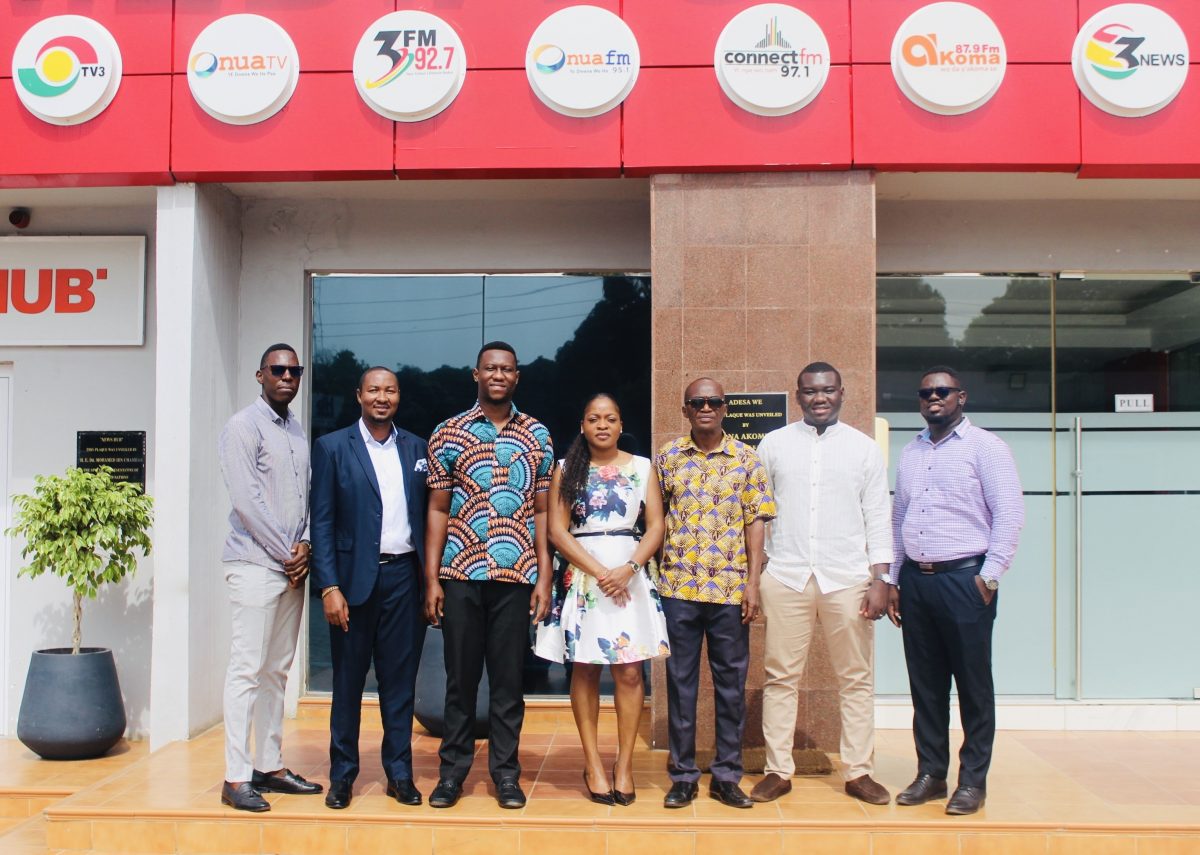
5. Planning for Long-Term Sustainability and Capacity Building
As VIFAA’s end date approached, one pressing challenge was ensuring that local partners like AFO had the technical capacity to maintain and expand the dashboards. While AFO has strong sectoral expertise, sustaining and upgrading complex data dashboards requires specialized technical skills. This highlights the importance of incorporating capacity-building activities from the outset to enable local ownership.
The VIFAA team began capacity-building efforts with AFO but recognized the need to further embed technical expertise within the team to manage complex tech components independently and build on existing capabilities.
Lesson: Programs should plan for capacity-building activities from the start, including technical training and simplified processes that enable local partners to maintain and adapt tools independently.
Reflections and Takeaways
The VIFAA program leaves us with valuable lessons for bridging data gaps and driving meaningful, data-informed change in agriculture. Collaboration with stakeholders during the design process ensures tools reflect local needs, building ownership, and sustainability. Establishing trust with private-sector partners through measures like NDAs opens access to critical data while fostering deeper collaboration. Tailoring approaches to fit each country’s unique context enhances the relevance and impact of solutions. At the same time, innovative methods, such as satellite imagery and modeling, address persistent data challenges and unlock new insights. Finally, investing in local capacity from the start ensures that partners can maintain and expand tools long after the program concludes. Together, these lessons highlight the importance of collaboration, adaptability, innovation, and long-term planning in creating lasting change.
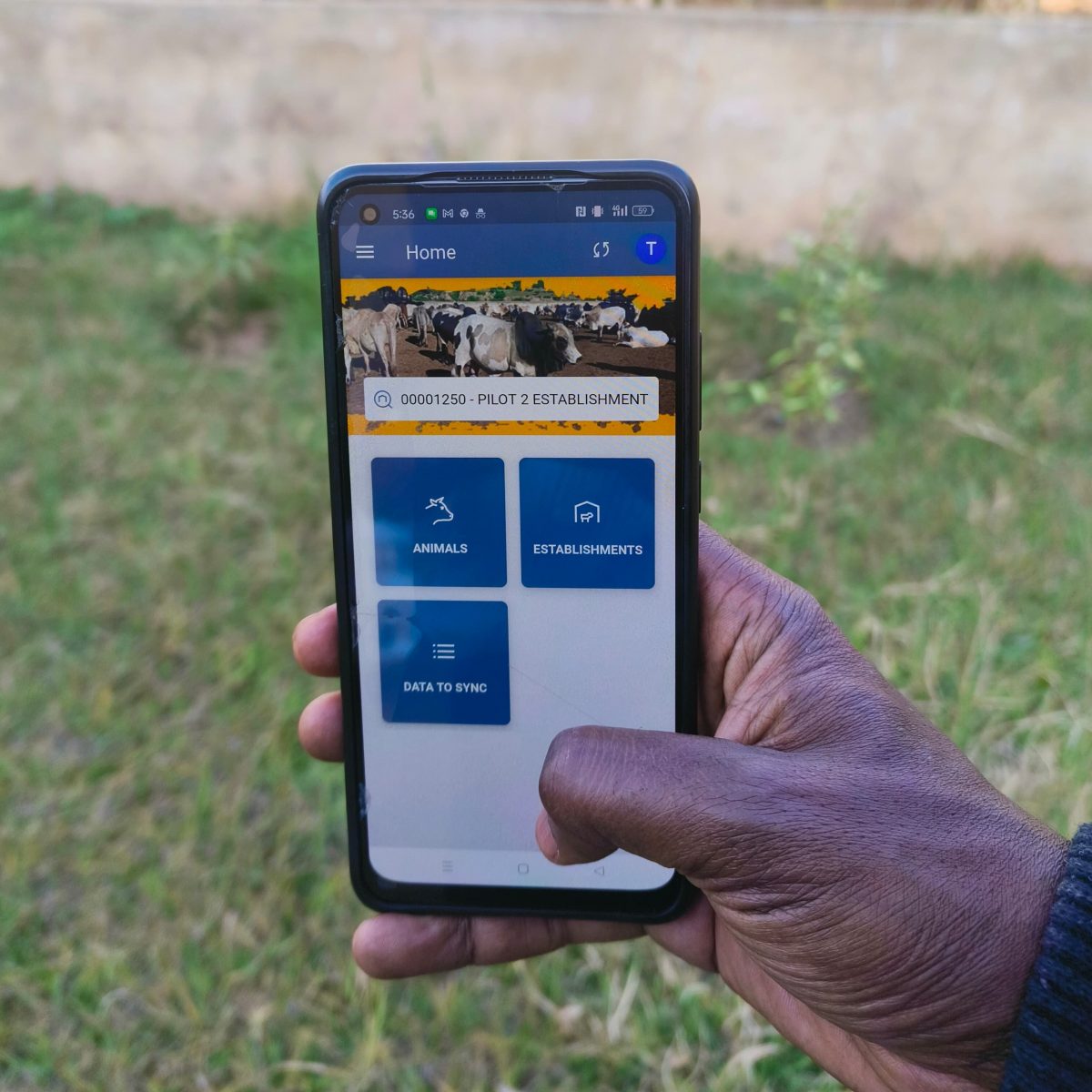
Enhancing Livestock Traceability in Ethiopia with Mobile Tech
Ethiopia has the largest livestock population in Africa, with over 70 million cattle, 95 million sheep and goats, and 8 million camels as of 2024, according to The World Bank. To support the effective management of this vast sector, Development Gateway (DG), through the aLIVE program, is working to enhance key livestock information systems for Ethiopia’s Ministry of Agriculture (MoA).
One significant improvement has been the development of a companion mobile app for Ethiopia Livestock Identification and Traceability System ( ET-LITS) over the past year. Unlike the original ET-LITS web application, which was not designed for mobile devices or offline use, this mobile app enables animal registration and tracking directly from the field—even in remote areas with limited connectivity, such as feedlots, abattoirs, and farms.
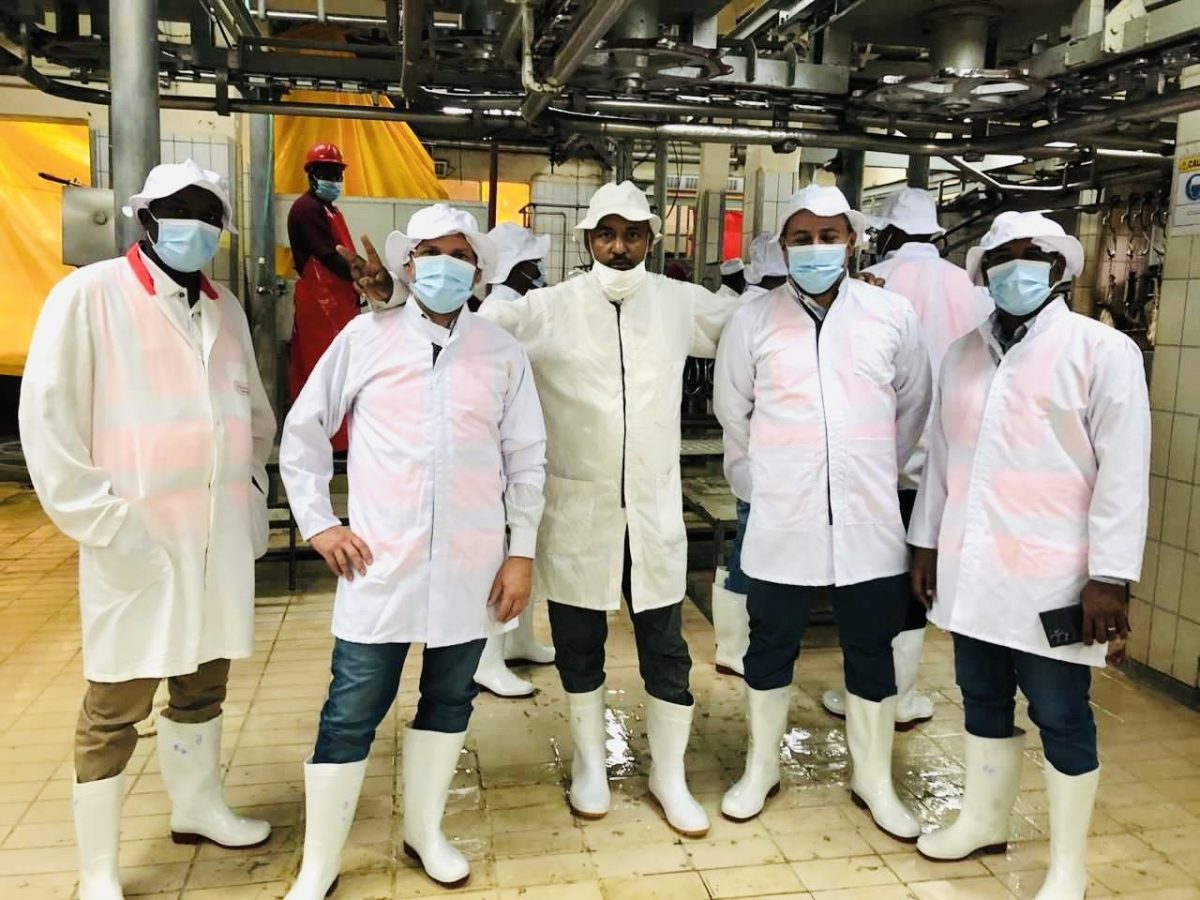
Previously, animal registration in these areas was done using paper forms, which were then manually entered into ET-LITS at offices with internet access. This process was prone to errors, difficult to scale, and did not provide real-time data. The new mobile app addresses these issues, allowing the MoA to expand animal identification, registration, and event recording (such as health events) across the country.
Data collected in the field through the app will also be integrated into the Livestock Information System (LIS), currently under development as part of the aLIVE program. LIS will enhance the MoA’s capacity to analyze and utilize livestock data in decision-making.
Mobile App Features
The ET-LITS mobile app offers the following key features:
- Animal Registration: Used for registering and tagging animals.
- Animal Movement Request: Records animal movements between establishments.
- Health Events: Allows recording of health-related events such as vaccinations, treatments, and sampling.
To facilitate offline data collection, the app downloads reference data (e.g., establishments, locations, animal breeds) while online and stores it on the device. Users can then work in the field in offline mode. Once back online, they can synchronize the collected data with the backend.
During synchronization, the data collected on the mobile app is submitted to the same workflow processes used by the ET-LITS web application, ensuring that both platforms follow the same business rules.
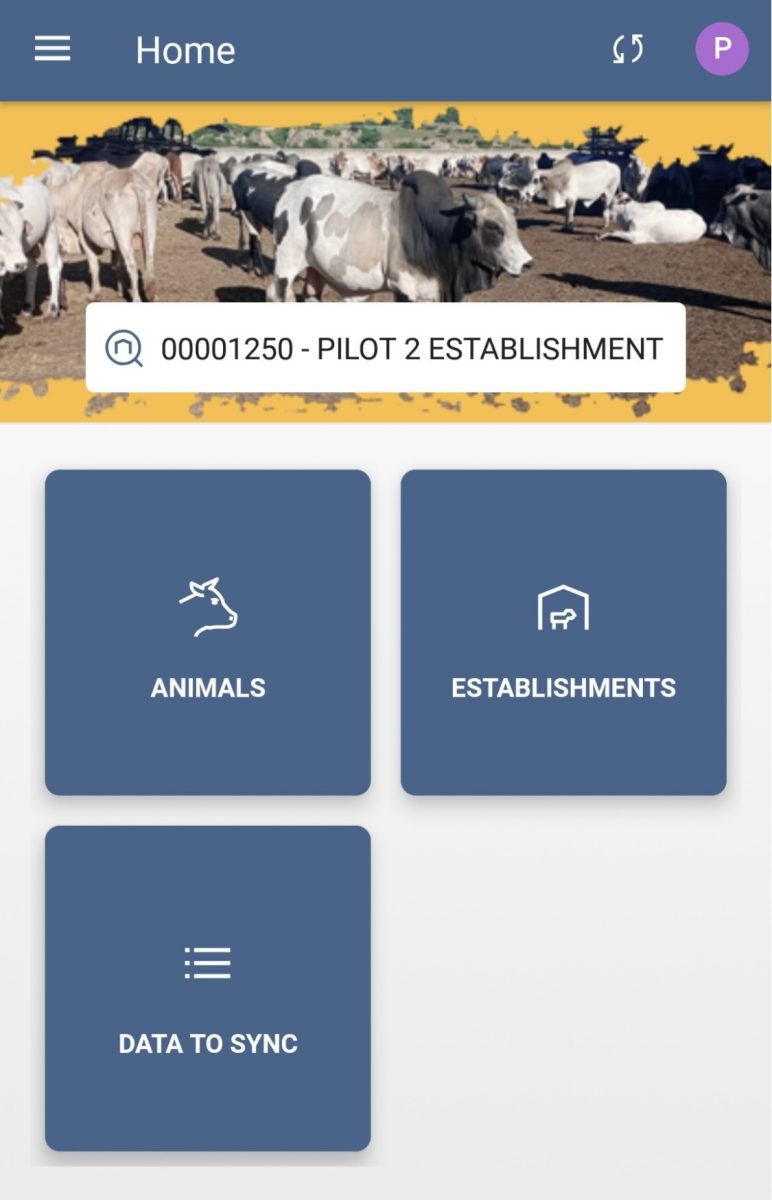
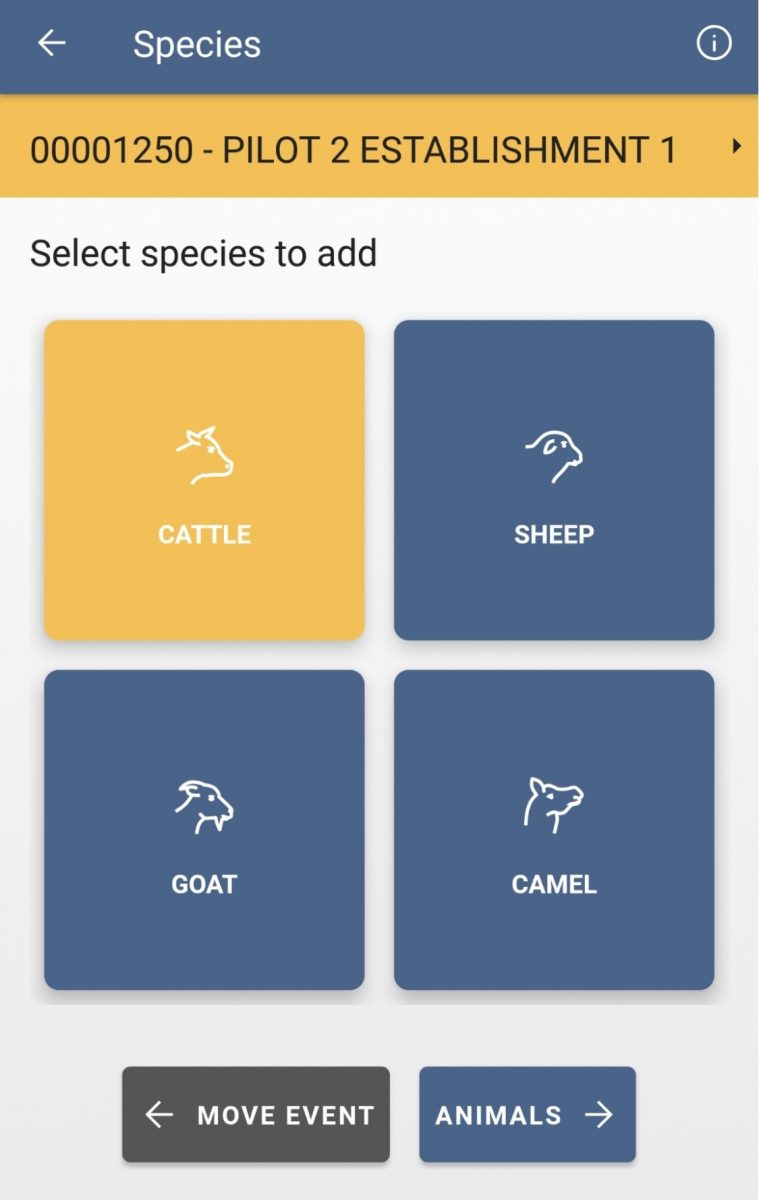
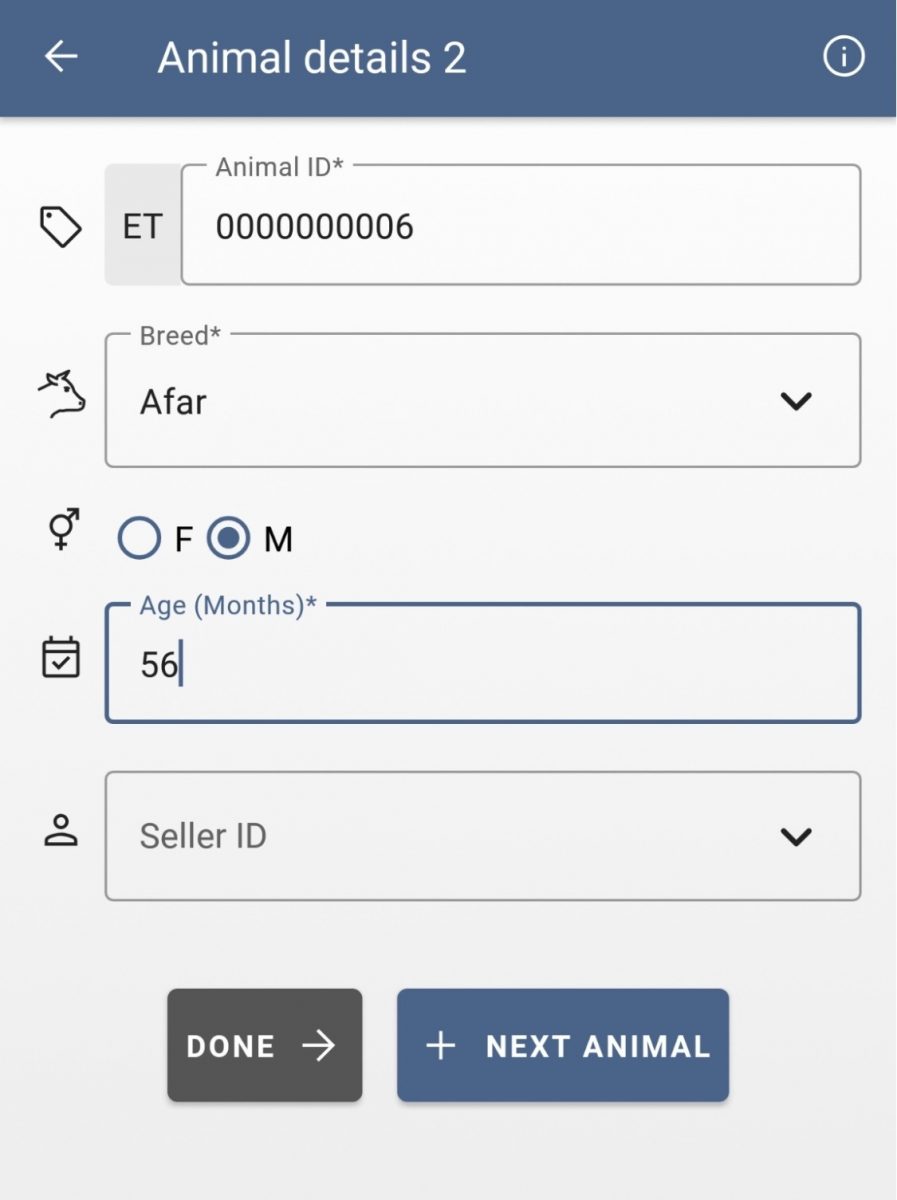
Technology and Architecture
The ET-LITS mobile app is developed in Java using the Android SDK. We chose the Android SDK because Android is the most widely used smartphone operating system in Ethiopia. Additionally, this approach enables installation on over 30,000 tablets available to the Ministry of Agriculture.
The app uses a well-organized layered architecture to improve functionality and create a smooth experience for users. At the foundation, an SQLite database is managed with the Room library, which allows fast and efficient access to stored data, ensuring quick responses within the app. The architecture is made up of several components, each with a specific role:
- Entity Classes define the data structure, shaping how information like animal records or health events is stored and organized.
- Data Access Classes manage the communication with the database, ensuring reliable data retrieval and updates.
- Repositories act as a bridge between the app’s data sources (like databases or network sources) and the app itself, providing a consistent way to access and update data.
Additionally, ViewModels are used to manage data for the user interface in a way that’s aware of the app’s lifecycle, which helps maintain data stability and prevents unnecessary loading. For the end user, this structured approach means a faster, more responsive app that can reliably handle complex tasks, even as the app evolves or scales with new features.

Agile Development Process
When we faced the challenge of managing multiple deliverables simultaneously, we understood that the Scrum methodology within our well-known DG Agile Framework was the way to go to maintain efficiency and focus. The team had 8 team members assigned to work on 4 deliverables simultaneously, covering the different roles (ET-LITS Mobile Application, ET-LITS Web application, LIS Architecture, and LIS Dashboard). The key to success in this multi-deliverable environment was to ensure that each had its own set of tasks prioritized (project backlog). However, instead of splitting the team across different products, we adopted a flexible sprint planning process that allowed the team to shift their focus based on the priority and complexity of tasks.
In this setup, a single Scrum Master, in close collaboration with the Technical manager, facilitated the daily stand-ups, sprint planning, and retrospectives, ensuring that the team’s focus, priorities, and objectives were clearly defined, achieved, and reviewed. By using a shared sprint board, allowing to view all projects in one, the team was able to collaborate on overlapping tasks while keeping track of the dependencies. Each development cycle (sprint) was time-boxed to two weeks, allowing for regular reviews of progress and quick adjustments when necessary. Demos were presented regularly based on what was important to accomplish at a certain point of the development phase.
The scrum framework flexibility enabled us to manage multiple workflows, while regular demos and retrospectives helped the team adapt and continuously improve performance.
Continuous Integration & Continuous Deployment
To ensure the ET-LITS mobile app is reliable and always up-to-date, we use specific tools for building, distributing, and tracking any errors. Continuous Integration and Continuous Delivery (CI/CD) tools help us quickly release new features, fix bugs, and maintain app stability. Here are the tools we use:
- Firebase App Distribution: This tool allows us to easily share new versions of the app with testers. By getting feedback early, we can make sure the app works well before it’s available to everyone.
- Firebase Crashlytics: Crashlytics helps us catch and fix errors by providing real-time crash reports. It pinpoints issues in the app, so we can quickly improve it and ensure users have a smooth experience.
Jenkins: Jenkins automates the process of building and testing new versions of the app. With Jenkins, we can release updates faster and make sure each new version is stable and works as expected.

Sustainability
To ensure the sustainability and ongoing improvement of the mobile app, DG has included software developers from the Ministry of Agriculture (MoA) in the development team. This collaboration has proven to be highly effective, with MoA developers actively contributing to enhancements and the integration of new features. This involvement not only fosters a sense of ownership among the MoA team but also ensures that the app continues to evolve in alignment with the specific needs and conditions of the local environment, securing its long-term relevance and utility.
Recognizing the complexity of the data pipeline, aLIVE is also equipping other professionals within the MoA such as epidemiologists, data analysts, animal welfare experts, and other data users with essential skills in data handling, processing, analysis, and visualization. The training program is designed to empower them with modern tools and techniques to enhance their decision-making. By strengthening their technical capacity, aLIVE ensures that data is not only collected but effectively transformed into actionable insights that improve outcomes across the sector.
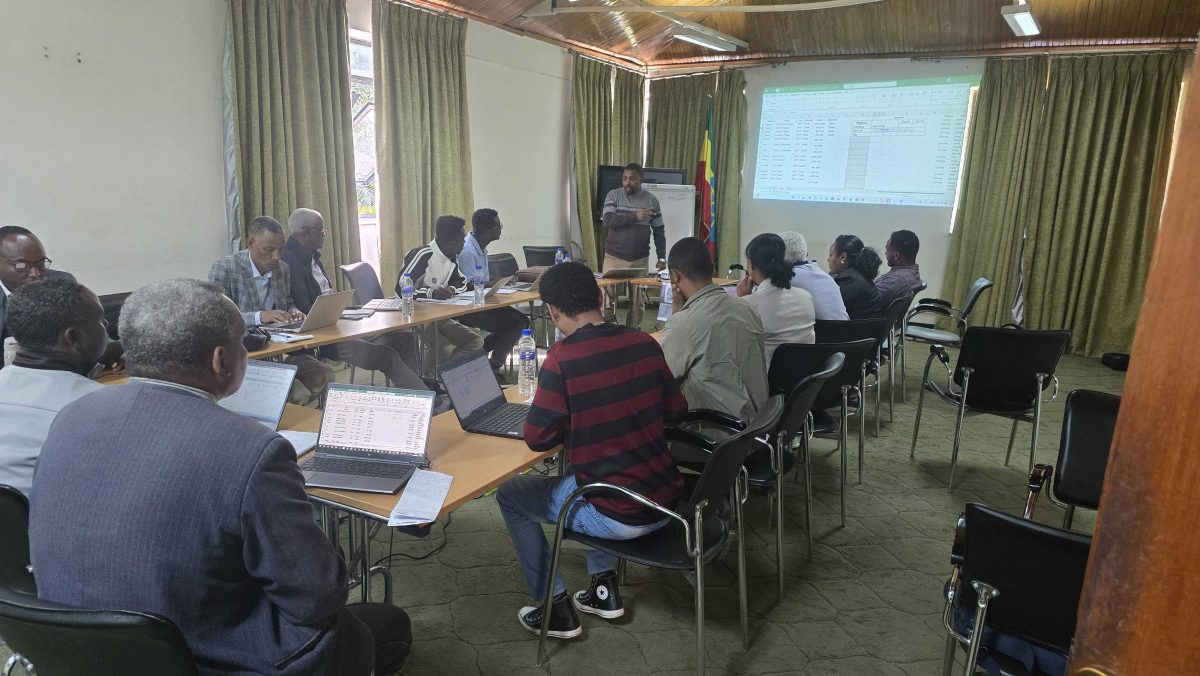
Next Steps
We are currently working on updates to align both the ET-LITS backend system and the mobile app with the new Livestock Data Standard developed through the ALIVE program. As part of our efforts to ensure a smooth transition, we are engaged in various knowledge transfer activities, such as training MoA developers on technologies and processes, and involving them in the development of additional features. At the same time, we continue to support the LIT Directorate as it conducts user testing in the field at locations such as abattoirs, feedlots, and quarantine centers. This testing is a crucial step in preparing for a full-scale production rollout in the coming months.

The Cancer-Tobacco Link: Using Data to Drive Stronger Tobacco Control Policies
As we observe World Cancer Day today, it is crucial to recognize the significant role smoking plays in the global cancer pandemic. Tobacco use is the leading preventable cause of cancer and cancer-related deaths worldwide, necessitating a dynamic, multidisciplinary approach to tobacco control interventions. DG’s Tobacco Control Data Initiative (TCDI) contains country-specific websites designed to break down barriers to data use in tobacco control by consolidating reliable, comprehensive information on tobacco use, including its impact on cancer.
These 6 country-specific websites provide critical data that reinforces the well-established causal link between tobacco use and cancer, offering a clear, evidence-based picture of the public health threat. The websites feature a wide array of data sources, including primary data collected through TCDI, publicly available secondary data, and peer-reviewed research. By consolidating these resources, TCDI aims to fill existing data gaps and empower stakeholders with the information needed to strengthen tobacco control efforts.
Smoking is the predominant cause of lung cancer cases, responsible for around 85% of all cases worldwide. This is notable given that lung cancer is the principal cause of cancer-related deaths and ranks as the sixth leading cause of death worldwide. Tobacco smoke contains over 7,000 toxic substances, including seven carcinogens that cause cells to grow abnormally, eventually leading to cancer. Even smokeless tobacco, which is chewed, sucked, or sniffed rather than smoked, contains more than 4,000 chemicals—28 of which are known carcinogens. These alarming facts underscore the urgent need for continued awareness and action to reduce tobacco use in the fight against cancer.
Contrary to common beliefs, smokeless tobacco poses significant health risks, often underestimated in comparison to smoking. A single dose of snuff, held in the mouth for about 30 minutes, delivers as much nicotine as four cigarettes, leading to nicotine levels in the blood that can be as high—or even higher—than those from smoking. This makes smokeless tobacco highly addictive, with snuff being even more so than chewing tobacco. Users of smokeless tobacco are at increased risk of developing malignant tumors, particularly in the pancreas, esophagus, and mouth. These risks highlight the severe health consequences of smokeless tobacco, challenging the misconception that it is a safer alternative to smoking.
The Dangers of Secondhand Smoke
There is also a misconception that secondhand smoke is not as harmful as direct smoking. In reality, even brief exposure to passive smoke poses serious health risks to non-smokers. Therefore, there is no safe level of exposure to secondhand smoke, meaning that non-smokers who breathe in secondhand smoke can suffer from serious conditions like coronary heart disease, stroke, and lung cancer. Those living with smokers face a 20% to 30% increased risk of lung cancer due to secondhand smoke’s immediate adverse effects on the cardiovascular system. The dangers extend beyond lung cancer, with evidence linking secondhand smoke to an increased risk of breast cancer, nasal sinus cancer, stroke, atherosclerosis, and even adult-onset asthma.
Similar to active smoking, the longer the duration and the higher the level of exposure to secondhand smoke, the greater the risk of developing lung cancer. These risks underscore the urgent need to protect non-smokers from secondhand smoke in all environments.
Cancer Deaths Attributed to TRIs in TCDI Focus Countries
Tobacco-related illnesses (TRIs) are a significant cause of cancer deaths worldwide, responsible for about 2.6 million cancer deaths in 2019 (the most recent year with available data), highlighting the urgent need for enhanced public health interventions. In Ethiopia, approximately 9,900 deaths are attributed to tobacco use annually, which contributes to a range of cancers as well as cardiovascular and respiratory diseases. Cancer, in general, accounts for 5.8% (2019) of the country’s total mortality, with 1,360 of those deaths directly linked to tobacco use. The cancers most commonly associated with tobacco include lung, laryngeal, esophageal, and oral cancers, among others, emphasizing the wide-reaching impact of tobacco on public health.
Similarly, in Kenya, tobacco-related cancers are responsible for a significant portion of the national cancer burden. A 2022 study, Tobacco Smoking-Attributable Mortality in Kenya, 2012–2021, provides the first comprehensive data on the morbidity and mortality linked to tobacco use in the country. This study found that nearly half (46%) of 2,000 Kenyan patients undergoing cancer treatment had a history of tobacco use, with oral-pharyngeal cancer emerging as the most common tobacco-related illness.
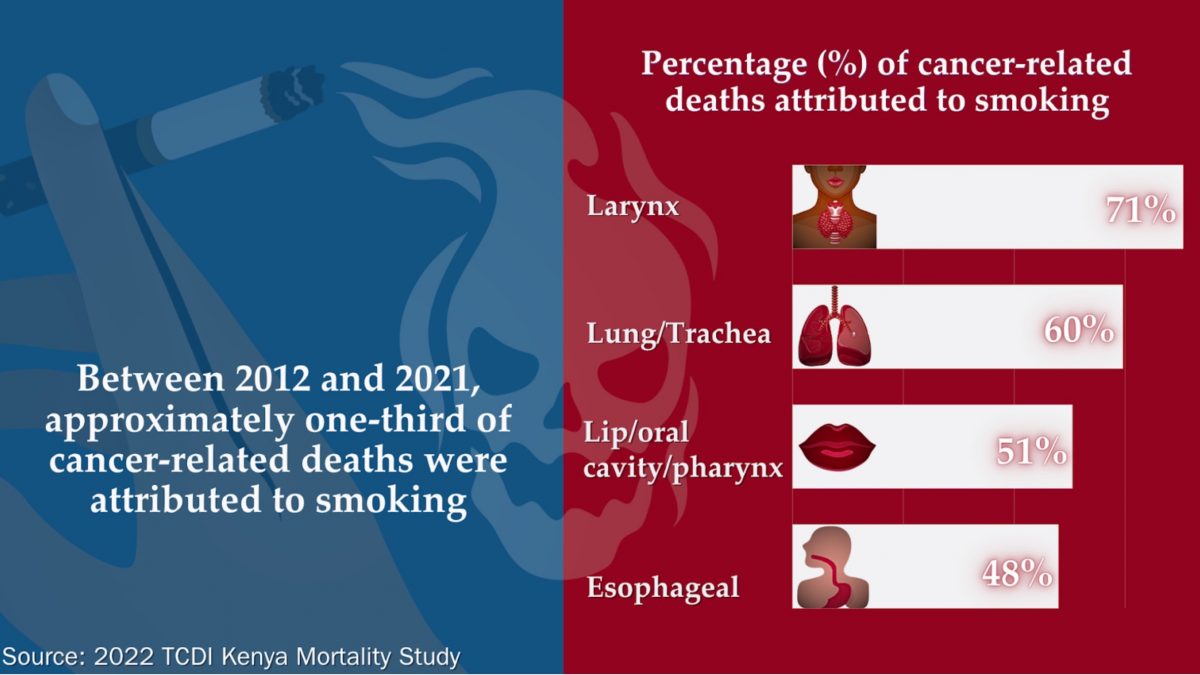
Men were disproportionately affected, making up 91.3% of the 9,934 deaths attributable to tobacco smoking, largely due to higher smoking rates among men.
These findings from both Ethiopia and Kenya underscore the devastating public health toll of tobacco use, particularly in the form of cancer-related deaths, and emphasize the critical need for multidisciplinary, evidence-based tobacco control strategies to reduce its impact.
Treatment and Healthcare Costs
TRIs not only devastate public health but also impose a heavy economic burden. According to Kenya’s 2022 study, the cost of treating patients with these illnesses is staggering, with lung cancer leading the way at $23,365 per case, followed by oral-pharyngeal cancer at $7,637. The majority of these costs stem from expenditures on medicine and medical staff. While cancers incur the highest treatment costs per case, they contribute less to overall healthcare spending compared to cardiovascular diseases. This is primarily because most cancer cases are diagnosed at advanced stages, limiting treatment options and resulting in poor outcomes and high fatality rates.
The Centre for the Study of the Economies of Africa’s (CSEA) study, Health Burden and Economic Costs of Tobacco Smoking in Nigeria, found that in 2019, 29,474 deaths were attributable to smoking, and the Nigerian healthcare system spends 526.4 billion Naira (the equivalent of USD 1.71 billion in 2019 NGN) in treating TRIs, annually. Researchers found that if the price of cigarettes were to increase by 50%, 23,838 deaths would be forestalled and the government would benefit from healthcare cost savings and increased tax revenue collection.
In 2021, TRIs in Kenya were responsible for significant economic losses, yet the revenue generated from the tobacco industry—through taxes and other contributions—covered only 63.8% of the estimated healthcare expenditures caused by tobacco use. This stark gap between the costs of treating TRIs and the revenues from tobacco taxation underscores the unsustainable economic impact of tobacco consumption.
Policy Recommendations for Public Health Interventions
Reducing cancer deaths linked to tobacco-related illnesses requires a dynamic, multidisciplinary approach to tobacco control that adapts to the political, socioeconomic, and cultural context of each region. Several strategies are essential across all six TCDI focus countries—Zambia, South Africa, Kenya, Ethiopia, DRC, and Nigeria. First, reinforcing the implementation of the Framework Convention on Tobacco Control (FCTC) to reduce tobacco use prevalence.
Alongside this, robust cessation programs must be integrated into diverse settings, including health facilities, workplaces, higher education institutions, and communities, to reach individuals across various stages of life and socio-economic backgrounds. Given that tobacco use is responsible for far more cancers than other adjustable behaviors– like consuming alcohol or physical inactivity–interventions aiming to help individuals quit smoking could have the most significant global impact on cancer prevention.
Gender mainstreaming is also vital; tobacco control policies and interventions should be designed with a gender perspective, recognizing the differing prevalence of tobacco use and associated health outcomes between men and women.
Further, comprehensive data collection is necessary to assess and monitor the tobacco epidemic effectively. This includes systematically gathering data on both morbidity and mortality rates related to tobacco use, such as the incidence of lung cancer, cardiovascular diseases, and respiratory disorders. In addition to clinical data, there should be linkages between electronic health records and national registries to enable real-time monitoring and trend analysis. Surveys and population-based studies can also provide insights into tobacco use patterns, including initiation, cessation rates, and the social determinants influencing tobacco consumption. This robust data collection will allow for consistent, evidence-based policy adjustments and interventions, ensuring that strategies to reduce tobacco use are responsive to local context and effective.
Expanding the scope of research to include tobacco-related morbidity, mortality, and the economic impact of diseases not covered in existing studies will offer a more complete picture of the toll of tobacco. Equally important is the responsible management of tobacco funds—resources collected from the tobacco industry should be used prudently to finance cessation programs and support healthcare costs associated with treating tobacco-related illnesses.
Finally, progressively increasing tobacco taxes remains one of the most effective tools to reduce consumption and alleviate the financial burden on healthcare systems. By combining these efforts into a cohesive, integrated approach, countries can make significant strides in reducing the devastating impact of tobacco use on public health.
